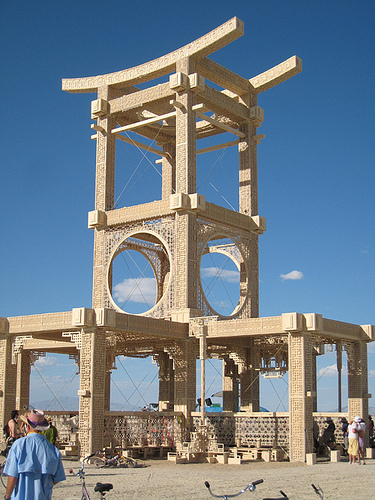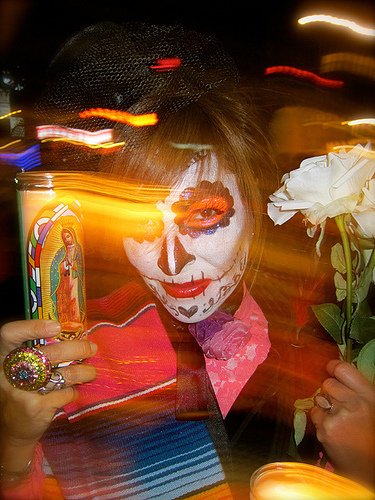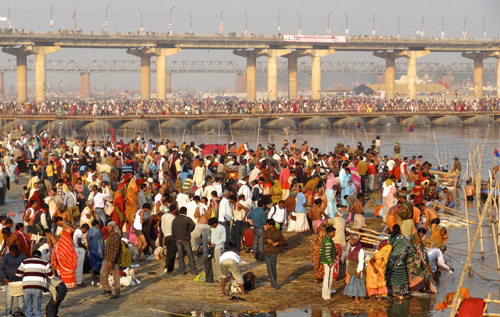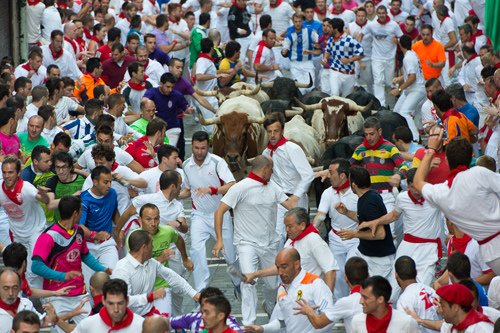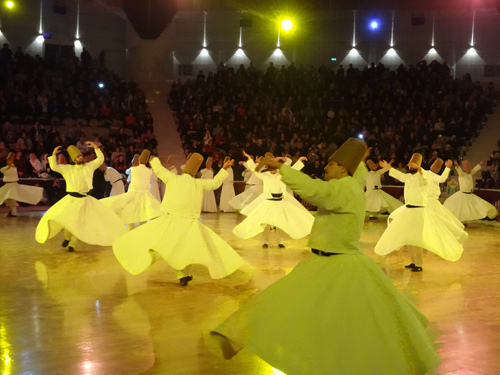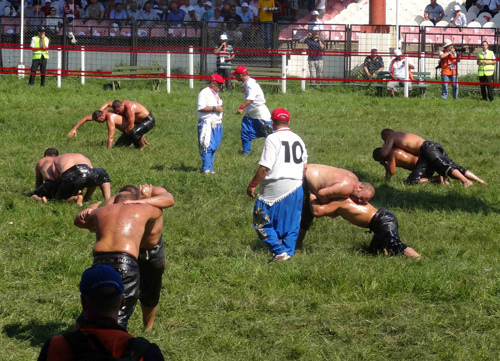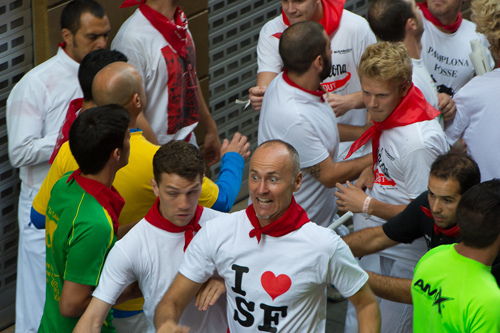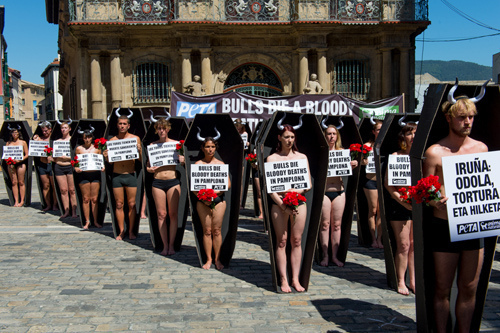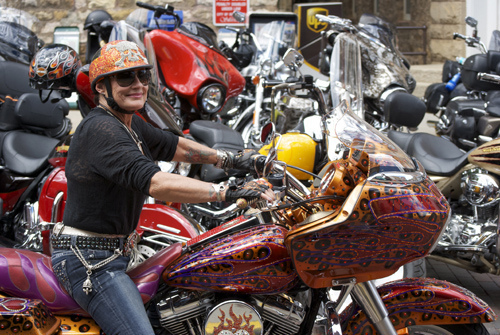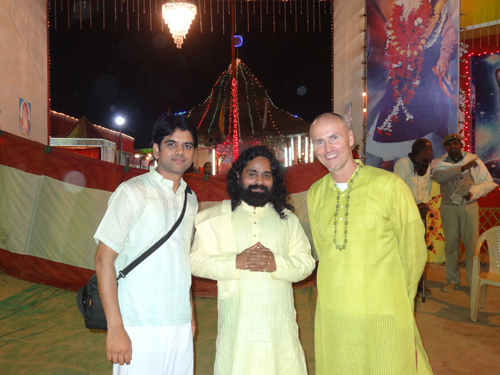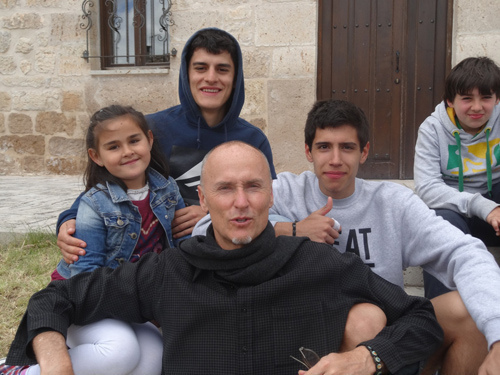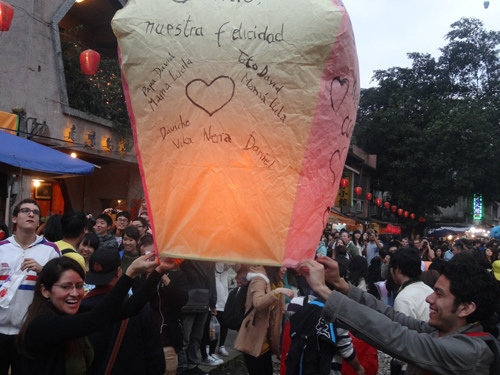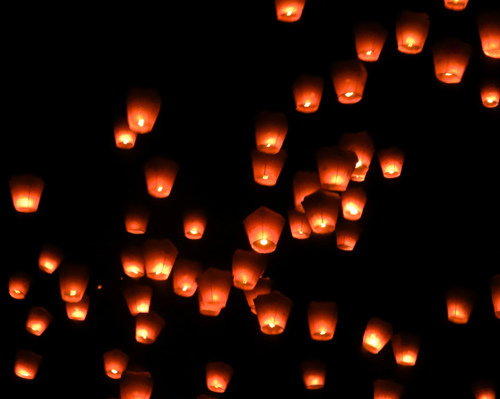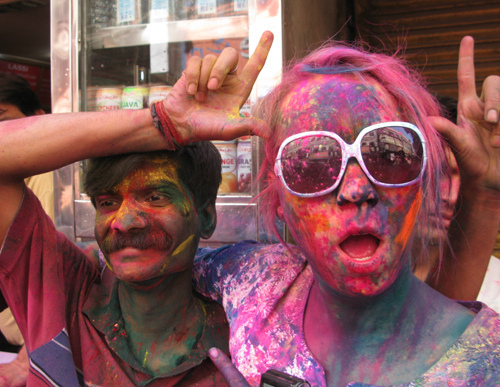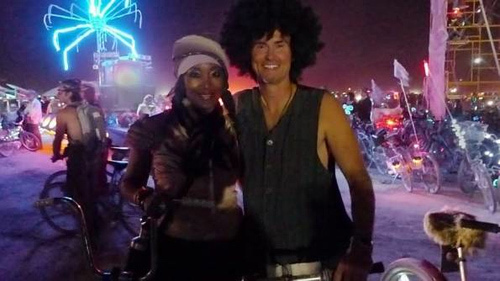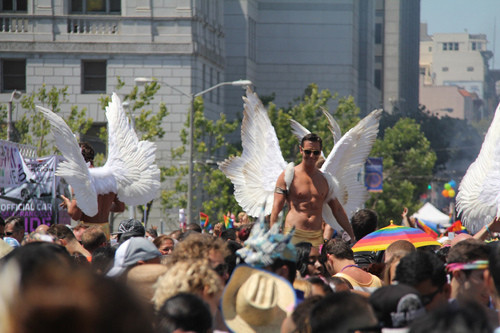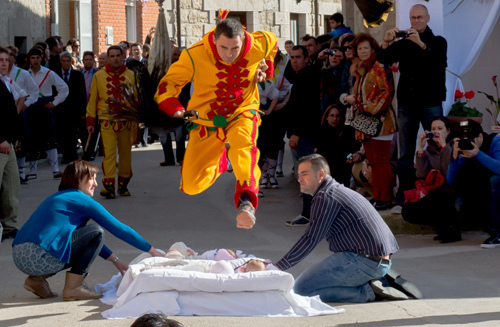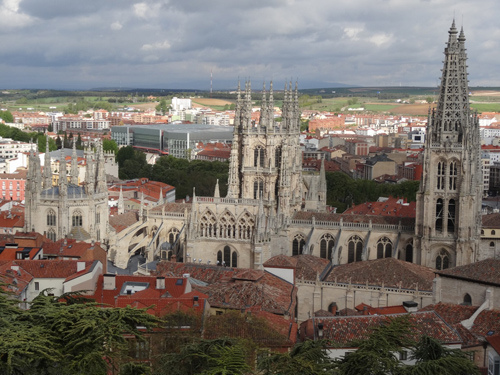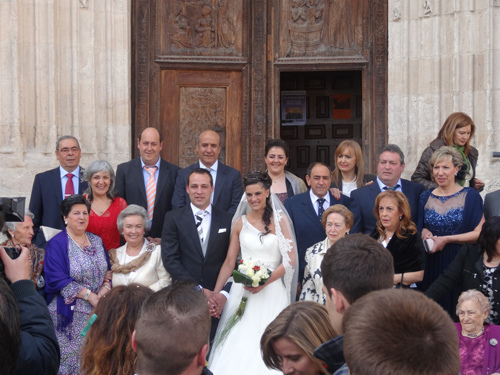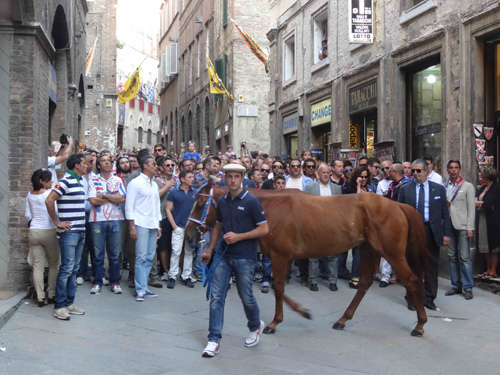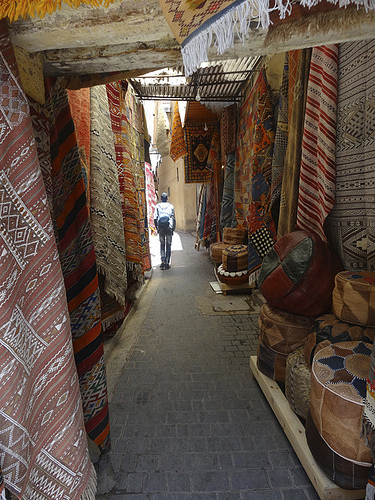Timothy Ferriss's Blog, page 109
August 19, 2013
Burning Man Winners and Charity:Water Finalists (Please Vote!)
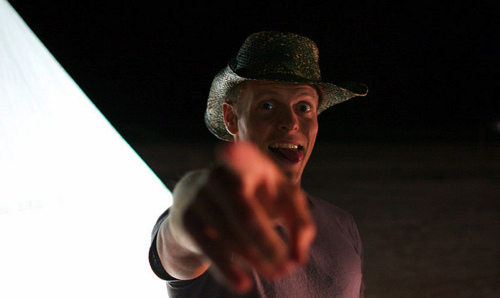
Goofing around at Burning Man ’08. Ah, the memories…
This is just a quick announcement post.
Below, please find the winners of Chip Conley’s Burning Man 2013 contest (See “28 Festivals and 8 Reasons They Can Change Your Life“), as well as the finalists for the Charity:Water roundtrip ticket anywhere in the world.
Please vote for your favorite Charity:Water finalist! The most votes wins — deadline is this Friday, Aug. 23 at 5pm PT.
First, Burning Man Tickets — Enter Chip
Wow, what an impressive and heartfelt collection of stories about how festivals have or could transform your lives! Thanks to the 250 people who shared with us. This was a difficult choice and, while only one person wins the two tickets to Burning Man 2013, I’ve selected one winner and three alternates depending upon whether the first place winner can use the tickets (since the event starts in a week and ends on the Monday of Labor Day). Congrats to these four! Tanis, DW, and Rebecca, we will immediately reach out to you if the person above you on the list can’t use the tickets.
For everyone else, take a look at Fest300 and imagine which festival might transform your life or give you a whole new perspective on how you could live your life. In this era of digital overload, festivals offer you the opportunity to connect more deeply with yourself and others.
FIRST PLACE…
Catherine Anne (aka Squirt Gun) — August 15th, 2013, 3:19 pm
I first attended Burning Man in 2006 and fell in love with the boy next door. Now we are married. I attend annually. As a sign language interpreter I noticed there were no services for Deaf Burners to fully connect with fellow Burners, so we created Playa Terps to provide interpreters. The two tickets will go to Deaf Burners who want to go this year. It’s not just about how Burning Man has changed my world, but how it is changing theirs too.
SECOND PLACE
Tanis M — August 16th, 2013, 9:40 am
Burning Man! I’m yearning, man!?
The fires of my soul never cease learning, man!?
First solo trip, In Germany I landed?
A journey of self and soul, my mind expanded.?
Wolkenkratzer Festival,?
One of the best of all…?
All of us souls, humans the same?
Dancing underneath Heaven’s warm rain?
Tears shed, and difference reside?
Teaching Oneness, our truthful ties.?
But Burning Man! I’m yearning, man!?
My soul craves this grand epitome,?
To bring present every bit of me.?
My bags are packed, I’m ready to go?
To Burning man, where I’ll continue to grow!
THIRD PLACE
dw — August 15th, 2013, 2:13 pm
In 2002 i lost my brother with whom i had first discovered festivals and travel for the sake of the soul. The loss was the result of an auto accident, and i was to blame. In the intervening decade i have attempted to restore a semblance of normalcy and happiness, with varying degrees of success and failure. My partner in life has helped me with this process, and once again we are traveling to festivals and finding the joy in life. Being immersed in burning man would help her and i on my journey towards forgiveness and light. thank you.
FOURTH PLACE
Rebecca Carter — August 15th, 2013, 11:06 am
My first burn was with this beautiful man, he warped my view of love and how I saw the world into something more giving and beautiful than I had ever imagined. Few years later we are pregnant and his father passes from aggressive cancer. We want to take his dad to the temple. It would be the best birthday gift I can think to give my husband. his birthday is Aug 26th. Help me give back to my giving husband and say Goodbye to his dad the only way a burner can. Its been too long. Thank you.
Second, Charity:Water Finalists — Time to Vote
You guys ROCK. I cannot begin to express how awesome you are. In just over a week, you raised more than $65,000 (including the promised $8,600 of my own money) to help solve the world’s clean water crisis.
As also promised, I’m giving away a free round-trip ticket anywhere in the world that Star Alliance flies, which is just about everywhere. There is no expiration date on the trip, and therefore no rush on deciding where or when to go. If the winner likes, I’ll fly them to San Francisco to have dinner with me, but other places might be far more interesting 
To pick the grand-prize winner, I need your help. Please vote for your favorite below! Deadline is this Friday, Aug. 23 at 5pm PT. The person with the most votes wins. There were so many great submissions that I chose six finalists instead of five. Keep in mind my criteria, summarized here:
Spread the word by sending people to the fundraising blog post or the donation page. Leave a comment telling me what you did (Facebook, Twitter, blog post, e-mail blast, e-mail signature, encouraged employees/friends to do the same, company donation matching, etc.). Measurement of any type gets huge bonus points.
HERE ARE THE SIX FINALISTS (THERE COMMENTS BELOW THE VOTING BOX)
(If you can’t see the form below, please click here)
Fill out my online form.
Sébastien ‘Go France’ Night
To me, education means helping someone to share their unique gift and be the best person they can be.
Half of my family are teachers (both my mom and dad are from families of eight, so that’s a whole lot of teachers), and so is my fiancee.?I teach communication skills and own or have owned 4 other businesses that are all education-related.?So learning and teaching is my life’s work and passion. That’s also what education means to me.
I scheduled to post this comment exactly within the deadline and I’m posting this right after crunching the numbers after the 1000th donation. If I messed up my time zone difference calculations, please still pick me.
This campaign for Charity:Water was very important to me because I’m just coming back from a 6-month trip around the world.? I’ve seen poor communities struggling in Brazil, South Africa and India and I can’t imagine how hard it must be to walk miles for clean water instead of just opening a faucet and having all the time in the world to run a business and create value like we do.
So I participated in your campaign because I wanted to send you a “Thank You” that would be meaningful.? Five years ago I read 4HWW and I dreamed of traveling the world with a beautiful woman on my arm… and this year I was able to do it while still growing my business (half a million euros in sales last year, and even more profit this year although I was working only 1 day a week)
So Here’s what I did to send you this “Thank You!”/”Pick Me” message
I have a whole lot of Facebook fans but after 5 years of raising money for charities with my business, I know that posting to FB doesn’t work. ?Nor do most of the other “weak-link” strategies (sending the link to friends so they check it out, twittering, etc)
All the 4- and 5-figure short campaigns I’ve succeeded with, used strong-link strategies and a template.
What I call a strong link is actually sending a one-to-one (or one-to-few) communication to someone who is on target with the message, and the 4 most important elements of the template I use are  - What is in it for the person?- What is in it for the beneficiary of the charity work?- What is in it for me.?- Call to action (with just one actual action to commit to)
- What is in it for the person?- What is in it for the beneficiary of the charity work?- What is in it for me.?- Call to action (with just one actual action to commit to)
I’m always transparent regarding what’s in it for me.?In this case, I candidly talked about my trip, and explained that I wanted to send Tim a “Thank you” note that would get noticed.
So I made a list of close customers and contacts, and wrote a personalized email to each of them.?(I had it sent, did not email each of them myself, because I’m email-free).
I wanted to be able to track numbers (a second nature for me) so I told people to add “Go France” before their name.?So if you wondered how all these crazy French people got there… now you know.
Something very interesting about my clients and contacts is that almost every single person that I knew would be interested in such a cause is an entrepreneur, investor or business owner. So I insisted on the “creating entrepreneurial callings in kids and women that would otherwise spend their life walking for water” angle.
Since I was bringing French people in, I asked them to donate EUR 36 EUROS (hence the USD $48 donations).?I did not link to the main Charity:Water page (one of my rules for charity campaigns : eliminate the clutter) ; I told everything in my very long email and gave them straight “payment page” links to donating $48.?(I split tested “$48, $480, or $1?, and “$48,$100, or $1?, and “$48, or $pick your own amount”. Guess which won?)
The results :
91 donors (9% of the entire campaign outside of Tim’s own donation) ?$5000, 36 in donations (11% of the entire campaign outside Tim’s own donation)
82% of the donations came from my closest customers – a group of 1,200 people
?18% came from my Mastermind group (friends that I meet several times a year to have fun and discuss business, lifestyle, and lots of other things) – a group of ~90 people.
And, what I’m most happy about: ?I donated my whole week of work (8 hours so far) for this but… I did all this while spending a week at an artist’s retreat in the North of France, and I drew my very first two portraits this week! ?So whoever you end up picking, nothing can bring me down from the happy feeling of this amazing week.
If you want more numbers, I can certainly get them.
Thank you!
Sebastien
Kris Byberg
I believe education is the ability to derive knowledge from our experiences. All too often do we confine education to the label of simply having gone to school. Yet learning is obviously not limited to the four walls of a classroom or lecture hall. By simply limiting education to an institutionalized environment, we are ignoring the vast wealth of knowledge that we derive from our everyday experiences out in the real world. Those striving to continuously educate themselves have turned the world into our classroom. A college degree is not what defines one’s education, it is simply a building block.
Regarding the charity: water campaign, after reading your post, I experienced several mind explosions of ideas after realizing the amount of potential resources I have access to. I currently work for a business development company that has a client called Nokero. Nokero’s mission is to eliminate kerosene fueled light in developing countries with solar light bulbs. Approximately 1.3 billion people still do not have reliable access to electricity. With that, millions are using kerosene as their fuel for light, and Nokero intends to replace kerosene with their innovative solar light bulbs. You can learn more about Nokero at their website, http://www.nokero.com.
Considering the similar social values shared between Nokero and charity: water, I decided to essentially pitch Nokero on a side campaign in support of the charity: water organization. For exactly one week, from July 21st until August 7th, Nokero has agreed to donate 10% of their total sales driven from this campaign to charity: water!
Once Nokero management had approved my proposal, I sent out an email blast (view screenshot here: http://bit.ly/1ehq7GZ) to their database of 5,785 emails. So far, of the 5,000, approximately 991 of them have viewed the email. Of those who viewed the email, 59 have gone to your campaign page through the link you provided. Although, unfortunately, I cannot track the amount donated by the directed visitors.. As Nokero just launched their 10% donation campaign, it is too early to measure any adequate sales figures.
To help fuel Nokero’s campaign, I have been blasting a similar email to all our relevant databases of a combined 135,777 emails, directing them to your campaign page. Of those 135,777, around 4,468 people have opened the email. But, unfortunately, only 47 have followed the link to your campaign page as this point in time.
In addition to the Nokero campaign, I personally donated $36 to your campaign before reaching out to my ~850 friends on Facebook.
The Straight Facts Up Now:
Over 144,367 individuals have been exposed to your campaign.
Approximately 110 have followed the link to your charity: water campaign page.
I’m anxious to see the final results of the Nokero campaign, which will end on August 7th. Despite your deadline being today for posts that quality for?Oh and, Tim, HAPPY BIRTHDAY! Thank you so much for an opportunity like this to directly make an impact on countless of lives. I wish you and charity: water the outmost success!
Kris Byberg – Denver, Colorado
Ashley Webb
To me, education means improving my thinking sufficient to break bread with you Tim in San Francisco and improving my thinking sufficient to make a significant contribution to the world.
To quote Russel M Nelson, the surgeon that invented the machine to bypass the heart and lungs for open heart surgery:
“Being educated is the difference between wishing you could do some good and being able to do some good.”
Thanks Tim for introducing charity:water and for writing the 4 hour series. I’ve met my best friends through the course of life you put me on in the 4 hour workweek and continuously the most inspiring people I meet and connect with are fans of yours.
TIM, HERES WHY THE APPROACH I TOOK BELOW IS YOUR CLEAR AND OBVIOUS WINNER!
As I jumped into this I ran across a quote by Scott Harrison about the actions to TRULY SOLVE the water crisis. He said:
“We can imagine solving these problems by the inevitable math of these networks of people…”
The inevitable math of the networks of people. I realized the most powerful approach would be the ones that tapped into exponential growth and intentionally influenced culture to cause repeated action and viral growth. I focused every strategy on applying the inevitable math of the networks of people for exponential growth!
(I also bitly linked everything for the huge bonus points you mentioned)
To start with, rather than make a donation and ask for individual donations, I split my test group donations into multiple donations.
I saw that charity:water has had great success with direct media so I tapped into that by combining direct media power and broadcast power. I wanted Facebook for social multiplication but also needed the power of direct and specific communication so I determined how to combine the two synergistically.
I went to Facebook and selected friends with upcoming birthdays because the birthday strategy is BRILLIANT and I wanted to piggy back on all the work done around it.
I sent direct messages to friends with birthdays and posted on their walls a video and a link. I gave them my heartfelt appreciation for who they are (I have AWESOME friends) because of their inspiration I made a donation in their honor to provide a well in Ethiopia. Because of them a village would have crystal clear drinking water for generations to come. I told them to follow the link for a special message to them which took them to the message and the donate page.
I wanted to see if my friends would regive. Sure enough, The first one came back encouraging others to give and that she had given $36. BOOM!
1. MULTIPLYING the original donation and tapping the “inevitable math”?2. Landed a targeted high potential NEW BIRTHDAY DONOR on the donate page who was enjoying a powerful emotional experience and is now invested into a charity:water well in their name. HIGH candidate for creating their own campaign, THE ULTIMATE DUPLICATION, to actually multiply what you Tim have done, donating a birthday over individual donation. This is a dramatic multiplying of the small donation given in their honor.?3. Charity water now has expanded their email list?4. The fb experience is no longer a broadcast. It plants charity:water right in the middle of a dramatic, touching emotional exchange of respect and generosity between two friends that the audience knows personally. HUGE social proof and cultural reinforcement.
First round total SUCCESS! Not only multiplying and leveraging what would have been a straight donation but massive social proof and establishing a new cultural behavior to give to charity:water in another persons name. I wanted to reinforce that even more.
Here are the kinds of posts shared:
My dear friend Ashley Webb made a birthday donation in my honor to bring clean drinking water to Ethiopia. This inspired me to make my own donation. What an awesome project.
I gave in honor of Richie Norton, Author of The Power of Starting Something Stupid (Fantastic book, endorsed by Seth Godin, Steve Forbes, Jack Canfield…)
This is what he said on his Facebook wall:
“Wow! Wow! wow! That is the most thoughtful gift ever! You really are an inspiration! Thanks so much for thinking of me and for changing the world for good. I deeply appreciate it!!!”
A huge endorsement of charity:water right there to his entire tribe!
That worked AWESOME!
I wanted to take it a step further. I did the same thing again but this time I “seeded” the gifts. I made a $10 donation, followed all the same steps as before but also paypalled my friend $10 to give to their fb friends birthday so they could have the same wonderful experience of honoring a friend that would appreciate it.
Now it is guaranteed to move forward one more person but when they get to the give page, the question is no longer “will you give” its “will you give more?” the giving is already seeded. Now its just a matter of bumping the number up.
I also passed the idea on to charity:water, they said it was fantastic
If I win, in the next phase I would like to releverage and gamify the trip to anywhere in the world. I think you will like it
Thanks again Tim, you and people that follow you are the people that have encouraged and inspired me when I’ve struggled to keep going and to hold on to the vision to be free to live our dreams in life and enjoy this incredible world while doing as much good as possible in our time in it. Thanks for leading the way and giving us tools to free up the bandwidth to join you.
In Hopes Of Breaking Bread With You In San Francisco,
Ashley Webb
Andreas
To me, education means to be given an equal chance, to make a difference, a positive impact and live a life fulfilled. It’s about putting our trust and hopes in our next generation to be better than us and do more.
I’ve been having a great month with a new paleo app I recently released and I thought it would be a great opportunity to give something back. Therefore, I ran a promotion in my eShop and I’m giving away the days profits to the campaign.
I share my results here: http://bit.ly/1chm3dj – the promotion was to over 9,000 eShop subscribers, over 7,300 Facebook and 13,000 twitter.
Sean McLaughlin
To me, education means growth. For the teacher and student alike, an exchange of knowledge enriches both, matures both, and benefits both. Regardless of topic, the net yield is always positive. Whether you teach love or hate, whether you learn fear or joy, growth will always be had via the exchange mechanism of education.
WHAT I DID:?- MONDAY (July 29) – Found out about this challenge.?- MONDAY – I bought the domain www.(censored per blog posting rules).org?- MONDAY – I built a website for it?- TUESDAY – Created the content,?- TUESDAY – TRIED to purchase $1000 in Google AdWords advertising (denied)?- WEDNESDAY – Hired a banner plane to fly around the Portland Metro area for 2 hours with “(my website name).org” streaming behind it. Flights occurred 4:30pm to 5:30pm Thursday and 8:30am to 9:30am Friday.?- THURSDAY – Trouble shot a server crash (due to the high volume of new traffic)?- THURSDAY / FRIDAY – Giddily monitored Google Analytics as PageViews SKYROCKETED! In a span of 2 hours I received 616 Pageviews. I have additional analytics to share if desired.
This entire process has been 1 big experiment. I’ve never created a usable website before. I’ve never purchased ad space of any kind, and I’ve never used any analytics software. After YEARS of sideline education, I decided to jump in with both feet to get the education that only first hand experience can deliver. And I’m so happy I did. After the thrilling roller coaster ride of emotions, and the successful leveraging of eustress, I feel ready and confident to ride the ride again. If nothing else, this has been the education of a lifetime and the exact catalyst I needed.
As a side note, this is a subject matter that is near and dear to my heart. As an Iraq vet with the Marine Corps and a backyard farm / sustainable living enthusiast, I am INTIMATELY familiar with the impact easy access to pure water makes. I’ve lived it.
Thank you Mr. Ferriss for the opportunity to be involved and for the example you gift us.
With deepest sincerity and warmest thanks,
Sean
Elaine Wilkes
What education means to me is resourcefulness. I connect the dots with all my learning experiences.
My PhD doesn’t mean Phfinally Done because the resourcefulness, memories, friendships, discipline, and love of learning that I gained from my education continue on.
I used Four Hour Work Week as my step-by-step guide to get donations—totaling well over $1000.00!
(Page 11—”Have fun and let the rest follow.”) I got excited that I could help people get clean drinking water. Wow. Just writing that I get goose bumps. So, with fun as the leader I began…
While everyone is Facebooking, tweeting, notifying their school bulletin boards, all of which I did, I read, (Page 11) “What if I did the opposite.”
What weren’t people doing?
I got an email from Pete Williams of PreneurMarketing.com about a webinar. (Page 321—automate.) I hit reply using my automated email. Pete responded and donated $360.00!
(Page 189—Google ad words) I contacted my virtual assistant about creating a Google ads campaign. He said he didn’t have enough time. I tried to explain Parkinson’s Law (page 77), but he wasn’t budging. I suck at Google ad words (page 208-know your weaknesses), so it’s a no-go with ad words. Movin’ on.
(Page 129—Delegate.) I hired an elancer from India. I instructed him (page 152—give precise directions) to find contacts of the people who interviewed Tim from YouTube videos. I figured friends would be happy to give.
(Page 179-microtest first.) I tested the idea. App mogul, Chad Muretta’s peeps responded right back with, “Thanks for reaching out! Chad just gave.”
Silicon Valley investor, David Sze, also replied with, “Sure. Will do now.”
So I hired the elancer to find more contacts. Friends were happy to give.
Then I get an email from a bigwig who saw my Twitter. He was my third “seemingly impossible person” to contact. I was investigating his contact info, and then—he emailed me! GET OUT! Is that a coincidence or what! Dodododododo. (That’s the Twilight Zone theme.)
He wrote, “Just responding to your tweet regarding Tim’s birthday wishes. Feel free to reach out directly.” (Will hear tomorrow.)
Now I feel such deep gratitude for those people who donated, and joy for the people who will receive clean water.
Happy Birthday Tim!
###
Here’s another chance to vote for your favorite finalist!
Fill out my online form.






August 15, 2013
28 Festivals and 8 Reasons They Can Change Your Life (Plus: Free Burning Man Tickets!)

Chip Conley, founder of Joie de Vivre Hotels.
Chip Conley is the founder of Joie de Vivre Hospitality, which he began at age 26 and built to more than 30 properties in California alone. In 2010, Joie de Vivre was awarded the #1 customer service award in the U.S. by Market Metrix (Upper Upscale hotel category).
Conley has also been named the “Most Innovative CEO” in the Bay Area by the San Francisco Business Times, and I’m proud to call him a friend.
Last year, he decided that he wanted to become the world’s leading expert on festivals.
Why? Because he’d seen his personal and professional lives transformed by places like Bali and Burning Man. Since that decision, he’s traveled to more than two-dozen countries to experience more than three-dozen festivals and launched Fest300.
Why are festivals — one of the mankind’s oldest traditions — most important than ever in a digital world? What are Chip’s favorite festivals and how can they tranform your life?
This post — full of inspirational photographs — answers all of these questions.
Chip is also giving away two free tickets to this month’s sold-out Burning Man, which include drinks with Chip and quite possibly Larry Harvey, the founder of Burning Man. Deadline for submissions is this Friday! Details at the end of this post.
Enjoy…
Enter Chip
8 REASONS WHY FESTIVALS CAN TRANSFORM YOUR LIFE
1) The more virtual we get, the more ritual we need.
As we become more reliant on our iPhones, and more “connected” through Facebook, we can actually become more disconnected from each other. Real connection is what we crave. Festivals are as old as humanity, but in the digital era there’s a new peak in the magnetic attraction to extraordinary human gatherings. Whole festival genres such as transformational (Jeet Kei Leung TEDx Vancouver) and EDM (Chicago EDM Tribute) have doubled in size over the past decade. There’s an immediacy available when we put down our smart phones and dive into the present moment at a festival. Because what we need are IRL (In Real Life) experiences, while we drown in a sea of URLs.
Digital overload may be a first world problem, and not an immediate matter of life and death. But, on parts of Bali and at Burning Man, cell and wireless connections are rare or nonexistent. Life and death are immediate as they are ritualized in community and in fire – far from anything virtual. My festival transformation was forged in the fires of both.
Bali rekindled my childhood love of festivals, which is why I’ve returned over a dozen times. From birth to death, the Balinese culture is grounded in festivals. The Balinese honor the passing of life during the light of day with public cremations that celebrate the dearly departed while they often lie in full view…
then send them to the heavens in grand funeral pyres…
The community must be present to complete the journey, yet you need not live there to feel right at home. There’s a freedom in facing the inevitability of death together, which provides a sense of meaningful connectedness in this shared theater of life.
Burning Man founder Larry Harvey burned an effigy in his own image on a San Francisco beach to transform his broken heart.
25+ years later, Burning Man’s climactic night of burning “The Man” in the desolate wilderness of Black Rock City’s playa is now the penultimate inferno at this annual event that will host a record 68,000 people in 2013. The final burn is actually that of the Temple…
an enormous temporary structure that acts as a receptacle for words, pictures and totems, ritually deposited during the week with a combustible mixture of laughter and tears.
The Temple burns in an emotional bonfire on Burning Man’s final night…
Anyone who’s experienced this will tell you that, while there’s a lot of fun to be had at this world-renowned festival, there is – perhaps more importantly – a real opportunity to sink deep into connection with others…and with yourself.
2) Festivals redefine “vacation.”
Too many of us “vacate” ourselves during our precious time away from work, trading in the couch and a beer for a beach lounger and a colorful cocktail dressed with a tiny umbrella. We’ve been ritualized into taking vacations that lack discovery because we think the antidote to burnout is passing out by the pool. We need to retire the words “occupation” for our work and “vacation” for our play. Our breaks from daily routine should be transformational. When we’re in our 80s, the peak experiences we’ll remember will be the ones where we checked into new places with a fresh sprig of curiosity in our elixir of life. The truth is, most people in the world see their happiness and victories in the context of the group or village experience – what sociologist Emile Durkheim called “collective effervescence” 100 years ago. Make a pact with yourself to witness and experience some communal joy and attend at least one festival a year. You can take the pledge here. The good news is you don’t have to leap continents to do this. In many cities, there’s an art faire…
Carnival…
or Day of the Dead celebration very close to your own backyard.
The above shots were all taken near my backyard in San Francisco.
An authentic Mexican Dia de los Muertos experience in Oaxaca might be more of a bucket list kind of trip. Till then, seek out one near you this November. Art faires like the Bay Area’s Maker Faire bring together a mash up of DIY enthusiasts who can make just about anything out of a little bit of string, some tape and a vivid imagination. And, Rio’s definitely got some colorful competition at the Mission’s Carnival, which boasts incredible costumes, dancing, food, music and merriment every May. And you won’t find a single pool lounger anywhere in sight.
3) Cultural Curiosity = a more robust life + a more peaceful planet.
In the next 40 years, the world’s population will explode from 7 to 10 billion people. “I need some space” will take on new meaning as personal elbowroom becomes increasingly scarce. The security landscape has changed in the past decade, and the 24/7 barrage of negative media about “the other,” can induce fear at the thought of breaking out of what’s comfortable, or beyond what we know. Festivals are natural barrier disintegrators. At first glance, India’s sacred Kumbh Mela may seem to have little in common with the throngs who flock to Spain each year to run with the bulls. And, within just one country, Turkey’s Whirling Dervishes seem a world away from the modern day gladiators of its Oil Wrestling Championships. But cultural curiosity is a mindset that opens a window into “the other” and into our selves.
I joined the crowd at India’s Maha Kumbh Mela this year. A Kumbh Mela happens every three years, with four cities taking hosting turns. The Maha Kumbh Mela happens every 12 years and an estimated 100 million pilgrims came together in 2013. The international news focused on a train station stampede where 36 devotees lost their lives. Tragic, but not surprising given the numbers. What the reports missed is how this congregation of mass humanity can peacefully coexist for five weeks along the Ganges River. Proof that we humans don’t need as much personal space as perhaps we think.
On the streets of Pamplona, personal space is trumped by survival skills when thousands gather on two legs to escape a powerful few running on four (more on this in reason #4).
Whirling Dervishes have been twirling annually for nearly 750 years since the death of their beloved poet Rumi, and Kirkpinar’s wrestlers have been proudly competing for over six centuries. What I felt in my bones, because I was there in the flesh (I did get a chance to whirl, but only spectated the field games), was a real sense of commonality between these two disparate rituals and my own worldview. Whirling is sacred. There’s an intensity – both physical and psychological – that gets whipped up in the midst of the dance.
The oil wrestlers similarly push themselves to physical and psychological limits in a display of honor and reverence for their community today, and for the ancestors who came before them. Those of us observing are immediately connected by the transcendent energy of the dervishes in the arena and the intensity of the men on the field. In both instances, I became part of something far away from my “safe” little corner of the world. Clearly, I was the curious “other.” Yet, all barriers disappeared and we were merely humans…being.
4) Festivals allow you to push your limits.
For generations, status was defined by how you kept up with the Jones’s: the car in your driveway and the size of your swimming pool. With social media’s “status” updates, we’re seeing a big shift from being material-driven to being more experience-driven. Since we can now share our experiences in an instant, our triumphs are tied less to “tangibles” like a BMW, and more to the intangible IMF (in-the-moment feeling) that can be viewed vicariously by our friends. Some festivals are lively competitions that you can enthusiastically observe and enjoy from the stands (Naadam, Concurs de Castells, Il Palio). But, the greatest transformation factor is found in immersive experiences where you shift from passive spectator to active participant.
Taking part in competitions involves pushing through your own personal fear factor. I had the pure pleasure of spectating the Cooper’s Hill Cheese Rolling Competition in Gloucester, UK, witnessing brave – or crazy depending on how you see it – men and women race down an impossible incline risking limb and levity. First-time American winner Kenny Rackers was on a mission to inspire one million people to pursue their dreams…
Observing was the right choice for me, as I’ve nursed a seriously broken ankle before. Still, connecting with the locals and cheering on the racers induced a joyful IMF.
But, in Pamplona, I threw caution to the wind at the Fiesta de San Fermin. Donning the traditional red scarf and an “I Love SF” tee that works for my hometown of San Francisco and for San Fermin, I did more running from the bulls than with them. It was an exhilarating IMF.
Another limit was pushed when I learned more about the fate of the bulls. I honestly hadn’t considered the bullfight at the end of the day. Participating in the run and observing the PETA protests and The Running of the Nudes provided another P.O.V. that transformed my thinking about this festival.
Seeing both sides, without judgment, is not an easy task in life. Being on the ground and experiencing another culture’s rituals forces us to do what cultural anthropologist Angeles Arrien reminds when discussing the Latin origin of the word “respect,” which is respetar: to look again.
5) Festivals allow you to connect with new kindred spirits or experience collective effervescence with close friends.
Sure, you can go online 24/7 and find people to chat with about common interests. But that doesn’t compare with the intensity of being with them in person, whether the focus is on yoginis at Wanderlust…
or bikers at the Sturgis Motorcycle Rally…
Stepping outside your comfort zone means exactly that. Most of us are quite fond of our creature comforts and chosen tribe. Festivals can bring out the best and, sometimes, the worst in people. While we may yearn for new experiences and locales, our expectations can get in the way of enjoying what we may find there. Some festivals are inherently magical with serendipitous meetings of new friends and interesting locals at every turn. But, if you’re traveling alone, this may be asking too much of happenstance.
Traveling alone, I’ve made new friends of all ages, shapes and colors in languages shared and those helped along with interpreters, from the Kumbh Mela festival in India…
to the El Colacho baby-jumping festival in Spain.
If you prefer a traveling companion, kindred spirits can be just a click away. I often reach out to Facebook friends when headed to a festival. Last year, a friend doing business in Pakistan joined me spur of the moment in Turkey for the Mevlana Whirling Dervish festival. And a once virtual friend joined me last minute from the Philippines for a series of village festivals in Bali. Companion reality check: the wrong travel partner can be a real festival buzz kill. Be clear about why you’re going to a festival. If you’re looking for a life-altering transformative experience or just to find a casual hook-up, the best choice you might make is to travel with someone who has a comparable intent.
[TIM NOTE: See my related posts on free international housing in 20+ countries, as well as global volunteering as mini-retirements.]
#6 Festivals bring you face-to-face with the highest expression of the human spirit.
Later in his life, Abraham Maslow expanded on his iconic hierarchy of five human needs: 1. physical (food & shelter); 2. safety; 3. social (belonging); 4. esteem; 5. self-actualization. He added: 6. aesthetics and 7. transcendence. Art transcends cultural barriers. Feeling a part of something bigger than you is palpable at many festivals. Nowhere have I experienced this more deeply than in the midst of tens of thousands of people – from all over the world – writing their hopes and dreams on large paper lamps that become luminescent spiritual torches at Taiwan’s Pingxi Sky Lantern Festival.
The collective effervescence (there’s something about seeing it all together) of releasing these beacons into the sky is awe-inspiring, with a deep sense that our aspirations are all connected.
Seeing art in the every day gives you a new pair of eyes to see the world.
In his TED talk on the arts festival revolution, David Binder shares Australia’s Minto Live Festival and others with utter exuberance. These festivals show how the arts uniquely coalesce the local and the global. Art removes any sense of “the other” especially when the lines between performers and the audience are eliminated.
Two colorful festivals that express the enlightened, exuberant human spirit are at opposite ends of the temperature gauge. China’s Harbin Ice & Snow Sculpture Festival is an awe-inspiring display of artistic craft and superhuman endurance in -30 below freezing temps…

And India’s Holi (which has recently inspired similar festivals across the U.S.) transforms cultural barriers in the heat through a fantastic human rainbow of laughter and connection.
At both, the collective is necessary to inspire…and to be inspired.
7) Sometimes we need an event to facilitate transformation.
Transformation is a subjective term. One person’s metamorphosis might have a hedonistic flavor on an Ibiza dance floor, while another’s might emerge at a mountain monastery pilgrimage. I’ve experienced the gamut…profound moments that shifted big boulders in my life, as well as mind-blowing, in-the-moment connections that were just pure fun and frivolous.
I have also seen momentous shifts in the lives of others. One friend was at the top of his career and financially set, with a beautiful woman at his side. From the outside looking in, he had it all. You probably know someone like this. Or, perhaps it’s you. Are you miserable? My friend was. By the time he arrived at Burning Man, he’d gotten so used to seeing people as walking dollar signs that he’d lost his connection with humanity. What transpired over several days was nothing short of miraculous. By the time he left the playa, he was – and remains to this day – a changed man. What he needed was time, space and a completely new habitat – one based upon the gift economy and not the dog-eat-dog world – where he could let go and take a look at who he was at that particular time in his life…and who he wanted to be.
This could happen for couples who’ve lost their connection – traveling to the Buenos Aires Tango Festival to get their romantic mojo back. Or, someone dealing with a physical illness taking a trip to the World Bodypainting Festival in Austria to reclaim their body in Technicolor.
Or, maybe someone attends an LGBT Pride Festival after living a closeted life for too long.
Timing is everything. Find a festival that will allow you to welcome some transformation into your life. Marcus Aurelius wrote, “The universe is change, life is an opinion.” Maybe it’s time for a little change in your life?
8) The journey to a festival can provide surprising collateral benefits.
Many festivals are located in some of the world’s most fascinating towns or spectacular natural settings. When I traveled to Spain’s wacky baby-jumping festival this summer, I experienced a delightful bonus along the way. El Colacho is held in the small village of Castrillo de Murcia, where brightly hooded “devils” literally jump mattresses topped with infants to save their little souls.
This Catholic/pagan ritual has stood the test of time for four centuries, but as I trained my way from Madrid to northern Spain, I started having second thoughts about traveling so far for a small village festival that attracted lots of YouTube attention, yet scarcely more than a few dozen visitors. But, once I arrived in the charming, car-free, medieval town of Burgos – near the festival – I realized that El Colacho was the appetizer and Spain’s gastronomic capital, Burgos, was the main course…
The same happened while in Siena, Italy for Il Palio…
In Fes, Morocco for the Festival of World Sacred Music…
And at Kuala Lumpur’s Batu Caves for Thaipusam…
Now I’m imagining that I just might experience some collateral benefits in Tahiti for Heiva. Soon!
Beneath our varied exteriors lies a universal human landscape that connects us. Writer E.M. Forster’s humanistic epigraph to Howard’s End says it succinctly: “Only connect.”
Now it’s your turn…
How to Get Free Burning Man 2013 Tickets
Tim and I want to hear how festivals have transformed your life and/or why you are BURNING to go to a festival.
The most compelling story will garner two tickets to Burning Man (August 26 – September 2), and drinks with me (Chip) — and perhaps founder Larry Harvey — at First Camp on the Playa.
RULES
A) Entry = post 100 words or fewer in the comments below, telling us how festivals have rocked your world or why you have a burning desire to go to a festival.
B) Deadline = Friday, August 16, 2013 at 12 midnight PST
C) Winner = Announced Monday, August 19, 2013
D) Prize = 2 Burning Man Tickets sent overnight to your door + First Camp drinks
Look forward to hearing from you!






August 12, 2013
The Random Show, Episode 22 – Home Defense, Start-ups, Raccoon Throwing, Public Stock Investing, and Mail-Order Urine
There are dozens of topics covered in this wine-infused, bromantic episode of scatterbrained nonsense. Some of it might improve your stock picking or even save your labradoodle from being eaten alive. Or you can just choose to waste tons of money on awesomeness. O-tanoshimi dane!
This special edition of The Random Show was recorded and edited by Graham Hancock (@grahamhancock). For all previous episodes, including the epic China Scam episode, click here.
Below are all the show notes and links, courtesy of kind reader Jonathan Wu. Thanks, Jonathan!
FULL SHOW NOTES:
4) The Scavenger’s Guide to Haute Cuisine by Steve Rinella
5) Pee Mart
8) Foundation.kr (David Copperfield)
9) Theory 11 Magic Trick Online Guides
11) Stumbling on Happiness by Dan Gilbert
12) Predictably Irrational by Dan Ariely
13) Tim Ferriss Monthly Audio Podcast (TBA)? “Tim Tim Talk Talk”?
14) The Tech Guy by Leo Laporte
15) Foundations.kr with Jack Dorsey
16) The Graveyard Books Audiobook by Neil Gaiman
17) The Reality Dysfunction by Peter F. Hamilton
18) Foundation by Isaac Asimov
19) Ender’s Game Series by Orson Scott Card
20) Stranger in a Strange Land by Robert a Heinlein
21) Motherless Brooklyn by Jonathan Lethem
22) Kevin Rose’s Top 3 Stock Picks A. TSLA B. AMZN C. APPL
23) Netflix
24) Game of Thrones
26) Food Photography Made Easy
27) Flow Free
28) Heroes of Ismia
29) creativeLIVE free high-def classes






August 8, 2013
How Risk-Averse Entrepreneurs Succeed: Low-Cost Testing Using Reddit, PayPal, In-Person Pressure, and More
Entrepreneurs are risk-takers… or so the story goes.
In my experience, nothing could be further from the truth. Over the last 13 years in Silicon Valley, I’ve found that the homerun hitters are precisely the opposite: risk-averse. They mitigate downside whenever possible with low-cost and short-term testing. They’re often extremely ambitious and aggressive (e.g. Travis Kalanick of Uber or Elon Musk), but they aren’t remotely haphazard.
They’re methodical, and this is a learned trait.
The above video is a conversation between me, several first-time entrepreneurs, and Noah Kagan, CEO of AppSumo.com. In this video, Noah — who was an early employee at Facebook and Mint.com — covers his risk-minimizing methodologies:
In the first 20 minutes:
- His career path, including failures.
- How he has used low-cost testing in his own ventures.
- Why focusing on the small things (even trivial things) is a big thing.
- Common mistakes and coping mechanisms of first-time founders (e.g. seeking multiple co-founders).
In the second 40 minutes:
- Live critiques (in some cases, constructive tear-downs) of real companies and entrepreneurs.
- How entrepreneurs can make the jump from theory to revenue… in real-time.
- How you can immediately stop “playing business” without customer contact.
If you’re going to skip any part, skip the first 20 minutes. Though I enjoyed every minute, the last 40 minutes are especially must-see.
For more from Noah, be sure to check out his previous how-to posts on this blog, as well as his free upcoming course (9/26/13) on creativeLIVE: How to Overcome Fear and Get What You Want.
QUESTION OF THE DAY: What tools or services have you found most valuable for low-cost business validation? Any other tricks?






August 5, 2013
How to Travel to Exotic, Expensive Cities on $50 a Day

(Photo: Marc P. Demoz)
OK, I’ve had a few short posts recently.
Now it’s time for my favorite: a post you will want to print out, refer to often, and take with you on adventures. In this case, we’ll explore budget travel that is luxury travel.
But what does that mean? It means that traveling inexpensively is a decision for creativity, not simply a decision against excessive spending. Throwing money at a trip means you are ordering from the normal, plain-vanilla menu (e.g. Marriott or Four Seasons hotels). This often means physically changing locations without changing your perspective or worldview at all.
In contrast, looking at how locals live — and find hidden gems — ensures you have amazing experiences that no guidebook can capture. This post is written by Matt Kepnes, better known as “Nomadic Matt.” He didn’t have his first overseas trip until age 23, and now he’s traveled to more than 70 countries.
His specialty is engineering first-class trips from economy-class budgets… Perhaps it’s time for that trip you’ve been putting off?
Enjoy, and please share your own tips in the comments! Matt will be responding to questions there as well.
Enter Nomadic Matt
When I ask people why they don’t travel as much as they would like, the most common answer is “because of money.” This is also the saddest and most frustrating answer.
There is an illusion perpetrated by luxury resorts, travel magazines, and travel agencies, that the wonders of some of the greatest cities in the world are out of reach for ordinary folks.
When I started traveling the world in 2006, I made many rookie and costly mistakes. More than 70 countries later, I’ve developed a handful of strategies and tips that can be applied to any destination, no matter how expensive.
Thanks to this handful, I’ve relaxed in the fanciest hotels in the world and stayed in hundreds of hostels. I’ve flown first-class, flown economy class, and hitchhiked through Central America. I’ve eaten at luxury restaurants and street stalls. Seven years of traveling the world on a budget has shown me that you can enjoy the best the world has to offer without sitting in your room eating instant pasta. “Budget travel” doesn’t mean you can’t have some luxury.
Think about your dream destination. For that matter, think of the three most expensive and sought after cities: Paris, New York or Hong Kong. Wouldn’t it be great to spend a week in any of these cities while only spending $50 a day?
I’m going to show you how to hack these cities from top to bottom: what to do, where to eat, and where you can stay. In reading this post, you’ll also learn flexible principles that can be applied to any city you choose.
The Basics
Before we get to the specifics on each city, here are a few tips that will make flight, hotel, and bank fees vanish.
If this stuff bores you, feel free to skip directly to “City #1: Hacking Paris.”
Flights and Airline Points - I normally fly about 40,000 to 50,000 miles per year, which earns me enough frequent flier miles for a free flight in economy almost anywhere but you don’t need to have to fly to get a free flight – you can use branded travel credit cards and their sign up bonuses to fly free. I’ve accumulated close to a million miles by taking advantages of credit card bonuses.
If you really want to nerd out and get obsessed like I am, the links below will help turn you into a point hacker pro.
The Points Guy
Flyer Talk
Million Mile Secrets
Hack My Trip
Boarding Area
If you want to keep it simple, it’s best to just get one to two travel credit cards. Here’s what you do:
1. Sign up for a branded airline credit card: All U.S. airlines have a branded travel credit card that gives you 25,000-50,000 points when you sign up and meet their minimum spending requirements (which is sometimes just one purchase). Airline credit cards are the best way to jump-start your mileage balance. You can gain a lot of points really quickly. Personally, I use American Airlines Citi Card but for someone just starting out, I would consider getting two cards: one for your favorite airline—whatever it is–and a second card that has flexible points, i.e. points that can be used on any airline. Probably the best beginner card the second card is the Chase Sapphire Preferred because it’s easy to get, has a lower annual fee, and a larger sign up bonus.
2. Sign up for a non-airline credit card: Sign up for a non-airline credit card like a Chase or American Express card. You can use the points earned from these cards and transfer them to your preferred airline. Used in conjunction with step 1, you earn a lot of points very quickly. I recently got two Chase Ink cards and received 120,000 points, which I can transfer to a variety of different airlines.
3. Watch out for special promotions: I sign up for all the airline email lists on the airlines website. I always watch out for special 2-for-1 mile deals, or when they have special card offers to earn extra miles. American Airlines gave me 1,000 miles for watching a demo on their new shopping toolbar. I once got 5,000 miles for joining Netflix! Often times you get miles for filling out surveys or they will give you a 100% bonus on purchasing miles. Promotions help big time, and airlines seem to always be offering them. Utilizing promotions over the course of a few months can yield big results.
Words of caution: While it’s true that “churning and burning” (i.e. opening an closing a lot of credit cards at once) can hurt your credit, opening a few accounts over a year won’t kill your credit rating. I’ve been opening and closing accounts for years and I still have a credit score close to 800 and have never been denied a card. [Of course, be sure to pay off the balance/debt on the cards so you don’t pay fees, but I hope that goes without saying.] (A complete guide to the ins and outs of travel credit cards can be found here)
Accommodation: Hotel points are just as good as airline miles. I usually sign up for one or two hotel cards to get points for a couple of free night stays in any destination I visit (Recommendation: Starwood American Express). Hotels are not my first accommodation option but in case I can’t find budget accommodation or just want to pamper myself, these points are a good back up.
Bank fees: Don’t give banks your hard earn money via needless fees. If you’re American, you can avoid all ATMs fees by getting a Charles Schwab ATM card (no fees and they reimburse you for other bank’s fees). For non-Americans, join a bank in the Global ATM alliance. This is a group of banks that have come together to waive each other’s fees. Additionally, use one of these credit cards that don’t have any overseas transaction fees:
American Express Platinum
Chase Sapphire Preferred
United MileagePlus
Any Capital One card
Now, let’s get specific with our cities…
City #1: Hacking Paris
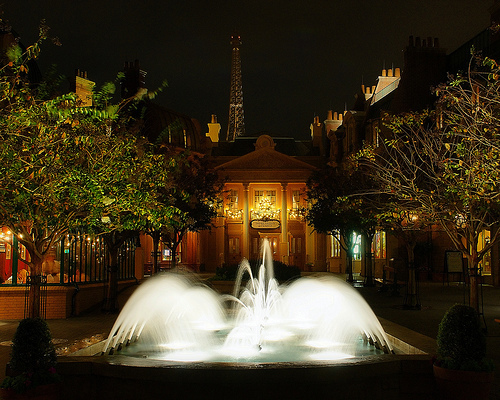
(Photo: Express Monorail)
The first time I stepped out of the metro and onto the Champs-Elysees, I feel in love with Paris. The lights, the ambience, the people. I was in love for life. Every subsequent trip has only deepened that love. All those movies about how wonderful Paris is aren’t lying to you. Paris exudes culture, sophistication, and style. Its museums and monuments are among some of the best in the world, especially if you love art. The food, the music, the wine, the women! (OK, for me, the French woman).
There is so much history in Paris, and the magic I see in movies like Midnight in Paris come alive every time I wander the streets, turn down cobblestone alleys and stumble upon a little café on a plaza where I can sit, drink some wine, and just enjoy the city’s magical energy.
However, Paris is not one of the cheaper cities in the world and a visit here can be expensive if you don’t plan right. It’s what turns most people off from visiting. They search on Expedia or Hotels.com and see $1,000 USD flights and $250 a night hotel rooms and think “no way”! But Paris has its secrets and as always there’s myriad of ways to reduce your expenses.
ACCOMMODATION:
Lodging is the biggest barrier to doing Paris on a budget. The single best decision you can make is to avoid Paris in July and August when rates are there highest. (Also, Paris is crazy crowded and hot then too! Go in the spring or fall to get better rates)
No matter when you go, there are five ways to avoid breaking the bank on accommodation:
Use Eurocheapo.com – This is the most comprehensive budget accommodation website for Europe and lists tons of properties not usually found on websites like Hotels.com or Expedia. When I’m looking for budget hotels, this is where I go. You’ll find small, family owned guesthouses they personally review not found anywhere else. Double rooms can start at $50 a night (i.e. only $25 per person).
Rent an apartment – In Paris, hotels are the most expensive place to stay. Enterprising Parisians have used this to rent out expensive space in their apartments to help pay their high rent. You can find a lot of guest rooms and apartments on sites like Airbnb, Wimdu, and Roomorama. Private double rooms begin at $40 USD per night ($20 per person). Single rooms or shared rooms start at around $30. Book at least a month in advance as these bargains book up fast and last minute spots are closer to $100.
Hostels – Hostels aren’t just for young kids – people of all ages stay in them. My favorite is St. Christopher’s Inn. Hostels in Paris are the cheapest option for single travelers with dorm rooms starting at $20 per night. You can book hostels on either Hostelworld or Hostelbookers.
Couchsurfing – Couchsurfing is a site that allows people to stay with locals for free. It’s a wonderful site – you not only get free accommodation but also get a local guide to give you the inside track on a destination. Through the site, I’ve learned about Aussie politics, Danish culture, and saw a German rock shows in Munich. Tim has a comprehensive guide to Couchsurfing here.
Accommodation is going to take up a large portion of your budget no matter but the more you save using these tips, the more you can splurge on food and activities.
FOOD:
The city of lights has some of the best and most expensive food in the world. Moving from market stall to market stall, sampling rich French food, and buying picnic supplies for lunch in front of the Eiffel Tower is an ideal morning for me. If you really want to try some truly amazing (and affordable) French food, skip any place listed in a guidebook, and do what the locals do, and visit the small cafes and markets.
Delicious market food meals can cost as little as $5. In my opinion the best markets in Paris: (This page lists all the markets in Paris:)
Rue Cler – Located near the Eiffel Tower, this street is filled with good Parisian eateries. You’ll find cheese, meat, bread, vegetables, and chocolate stores to explore. It’s one of my favorite streets in the city. Due to its location, it’s one of the more touristy markets, with slightly higher prices than others. Stick to the breads, meats, and cheeses here.
Rue Montorgueil – Half market, half foodie-paradise-shopping street, the pedestrianized Rue Montorgueil is filled with flower vendors, rotisseries, tempting bakers and fragrant cheese shops. Here your delicious and cheap options include hot chocolate at Charles Chocolatier, a pastry at Stohrer (the oldest pastry shop in Paris), and fruit and vegetables from the stalls. You can walk away from here with a large meal for 2-3 people for around $13 USD.
Monge – In Place Monge, not far from the Jardin des Plantes, the Arènes de Lutèce and the Panthéon, this little open-air market is one of the most well known markets in the city center. This market is open from Wednesday and Friday from 7.00 a.m. to 2.30 p.m. and Sunday between 7.00 a.m. and 3.00 p.m. It’s a popular market with locals and prices here tend to be the cheapest. Visit early to get the best selections. By the time lunch has rolled around, the freshest food is already gone.
Markets are going to be the most economical way to eat – and the most delicious. Markets survive and thrive in Paris because Parisians don’t have large kitchens and do their shopping every few days which means markets are always a hive of activity and deals.
Beyond just the markets, Paris offers many affordable meals. Just south of Notre Dame, Rue Dauphine has some worthwhile eateries. The place gets crowded with folks relaxing for drinks after dinner. Pull up a chair, grab a glass of wine, and people watch.
Two of my favorite restaurants are Jeanne A and Le Patio Provencal. Both offer delicious, rich, and inexpensive French food. Both are very off the beaten path but the staff does speak enough English where you can order without knowing French.
Jeanne A is also located near one of my favorite drinking spots, Josephine, in the Ménilmontant area, an area that is filled with affordable bars serving well priced drinks and often with live bands. While in Paris, avoid going clubbing. They are incredibly overpriced and often have a cover charge.
SIGHTSEEING TIPS:
The first thing any visitor needs to do is to get a Paris Museum Pass. This is a pre-paid pass that gets you access to over 60 museums and monuments around Paris. A 2-day PASS is only $51 USD, a 4-day pass is only $70 USD, and a 6-day pass is only $90 USD. And while this takes a big bit out of your daily budget, this pass will more than pay for itself. Without this pass, admission to the Louvre and Versailles alone are $40 USD!. Admission to those establishments plus the top museums in Paris would run something like $150 USD. Since most people visit lots of museums in the city, this pass is a great way to keep yourself to your $50 a day budget.
Crowds swarm the Eiffel Tower and Notre Dame Cathedral, creating long queues that wrap around each structure and can last for hours. Head there early in the morning or very late in the afternoon to avoid the rush. Lines start to form about an hour after opening.
The Latin Quarter is one of my favorite areas in Paris, and is less crowded than the touristy areas around the Louvre, Eiffel Tower, and Notre Dame. It is a calm and beautiful place to wander around. Head deep into the heart of it for tiny winding streets and cheap cafes that look out into little plazas. Be aware that the cafes get crowded with Parisians during lunch time. Come around noon (Parisians eat late) and you’ll find plenty of space.
The Louvre is the biggest museum in the world with thousands of square feet of space and millions of exhibits. Most people don’t know that the Louvre has discounted admission after 6pm on Fridays and free on Sundays. During the low season, it is also closed on Tuesdays. If you buy the Paris Museum Pass, you get free admission.
Be prepared to spend hours here and not even see it all. To see it all, you’ll need at least two full days. But for those without the desire or time to see it all, the best way to optimize your time is to go early, see the Mona Lisa first before the crowds, and then wander around seeing everything else in relative quiet as crowds overtake the Mona Lisa. When I visit the Louvre, I head straight there (also the Marriage of Cana right behind it is also pretty spectacular), and then wander around the museum. The crowds go right for the main course so while they jockey for space at the world’s most overrated painting, you get to stroll through the museum before the crowds disperse.
Additionally, to skip the long lines, use one of two entrances that most people have no idea exist. Enter via the side entrance in the Richelieu Wing, just across from where you exit the Louvre-Palais Royale metro.
For this entrance, you’ll need a ticket already. You can use your Paris Museum Pass will work or you can buy a ticket at one of the Paris tourist centers that dot the city. Additionally, you can also find short lines at the Porte des Lions entrance in the south western wing.
The Louvre and the impressionist museums (Musee D’Orsay and Musee D’Orangie) might get most of the attention but there are plenty of other great museums in the city – the amazing Rodin museum see a surprising dearth of visitors, the Holocaust museum is one of the best I’ve seen around the world, and the Paris Sewer museum gives you particularly interesting insight into one of the oldest and largest sewer systems in the world. All national museums are free admission on the first Sunday of every month. If you happen visit this day, be aware of potentially large crowds and long lines.
If you want a good view of the city but don’t want to wait to get to the top of the Eiffel Tower, head to Montmartre. I like coming up here, sitting near the Basilique du Sacré-Coeur for the view, and eating all the good food I found at one of the markets.
A visit to the Palace of Versailles (free with your Paris pass) requires a whole day. It gets very crowded, especially when all the tour groups arrive. To avoid the crowds, I trying to see the actual palace at the end of the day. People tend to move from the palace to the gardens so I work in the opposite direction. I start at Marie Antoinette’s home and then the gardens and then the palace. By mid-afternoon, there are fewer crowds and your pass gets you into everything all day. Otherwise, you can also get to the palace when it opens to avoid the long lines and stream of people.
Potential visitors often think Paris is expensive and that all those museums are just going to add up. Not necessarily. If you get the museum pass, the four-day pass only costs $17.5 USD. To maximize your time seeing the city, here is a five day itinerary for sightseeing Paris .
Paris is a huge and expensive city but like all places, there are ways to make it affordable. Once you skip the big hotels and don’t eat near the tourist attractions, you’ve pretty much lowered your big costs, allowing you to enjoy Paris more and worry less about money. The markets are cheap, drinks in Ménilmontant affordable, and the Paris pass saves hundreds.
You may not want to visit on only $50 a day, but there’s no reason need to spend hundreds here.
City #2: Hacking Hong Kong
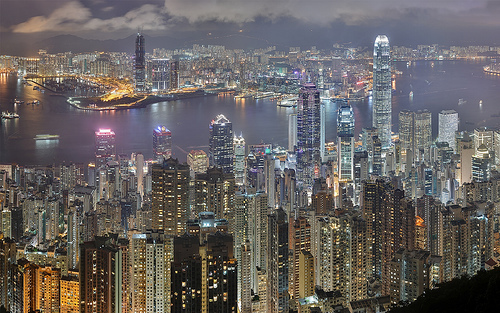
(Photo: Trodel)
Hong Kong is the like the New York City of the East–big, dense, hectic, multi-cultural, and open all hours.
But imagine New York City tucked into rolling green hills with towering crème and brown and pink skyscrapers that blend into one. When looking out at the city from the water, it looks as though someone photoshopped it into the mountains; this teeming metropolis set against a nature park.
Hong Kong: I can’t get enough of it.
I can eat at tiny dumpling shops while drinking dollar beers next to a seven-star hotel. How many cities can you do that in? And when you head out at night, you meet people from around the world. Hong Kong fascinated me before I visited – and then I went there and, ate there, and wandered its streets – and my fascination turned into love.
People think Hong Kong is expensive due to the massive high rises, banking industry, and expensive hotels. But the city located in Asia, a region of the world where those on the tiniest of budgets can make due thanks to guesthouses and an inexpensive street food culture that refuses to go away.
ACCOMMODATION:
In Hong Kong there are a few keys ways to not have accommodation eat your budget.
First, stay in Chungking Mansion. This dilapidated but interesting 17 story building on Kowloon island is home to cheap food stalls, markets (with goods that fall off the back of a truck), and plenty of cheap guesthouses where beds start at $15 USD a night. There’s nothing cheaper in the city.
Secondly, avoid staying on Hong Kong Island. Accommodation – from cheap guesthouses to expensive hotels – is much more expensive on this island (just like the island of Manhattan as we’ll see later). The other islands have much cheaper accommodation.
Your other options are slim but available. Airbnb and hostels all start around $20 a night for a dorm bed and go up to $40 for a private. You can Couchsurf but Hong Kong is a city where those free hotel points should be redeemed. All the major hotel chains are represented here and if you aren’t in the mood to share a room, redeem the points here.
FOOD:
While accommodation will eat a good chunk your budget, luckily food doesn’t have too. And it will be some of the best food in your life. Asia has a very pronounced street culture and all the major cities in the region have delicious meals (eaten by the locals en masse) served from street stalls. Hong Kong is no different.
To eat cheaply:
First, visit the local markets. Most locals shop at markets as they offer the cheapest and freshest foods, at times up to 50% cheaper than grocery stores. The Chun Yeung Street market in North Point, Hong Kong Island is one of the best. Many of the outdoor shopping markets also have small food vendors near them for quick, cheap and delicious eats. Meals will start at around a dollar.
Skip the fancy restaurants and instead go for the tiny little shops without the glitzy lights. You’ll find the best food there. In fact, Hong Kong boosts a dumpling shop called Tim Ho Wan that has a Michelin star. Get there when they open or the line is usually about two hours long. Some of my other favorite cheap eats include Mr. Wong’s (located right next to Tim Ho Wan), which has all you can eat and drink for only $8 USD. Mr. Wong is a character. He’ll joke around and keep serving you food until you can’t burst. Additional, the string of restaurants on Jardin’s Bazaar road at Causeway Bay has tons of tiny little vendors.
For cheap drinks, experience the nightlife at Lan Kwai Fong. LKF is the main nightlife and party area in Hong Kong and is filled with tons of bars, clubs, shisha bars, and cheap drinks. It’s where all the young folks go to party, so the drinks are pretty cheap.
TRANSPORTATION:
Hong Kong, except for the outlying areas, is pretty walkable. You can even walk up Victoria Peak if you don’t want to shell out for the tram. The city’s many walkways and skyways make for fascinating sightseeing in and of themselves, with steep stairs and glass-enclosed paths a city within a city. Additionally, take the Star Ferry between Kowloon and Hong Kong island. It’s only .30 USD cents and the cheapest way to get between the islands (plus the view of the skyline is great!). I especially enjoy taking it at night when the city high rises are all light up.
Taxis in Hong Kong are very expensive and should be general avoided by anyone on a budget. The train in Hong Kong can add up quickly as fares are based on distance. If you’re traveling fair in Hong Kong, getting a day pass for the train will be much more economical.
SIGHTSEEING TIPS:
Hong Kong has many cheap and free sights that will fill your days without emptying your wallet.
The Hong Kong Tourism office offers free cultural tours. Advance sign up is required but if you are interested in learning more about the local culture, this program is the best. Recently, a private company also started to do free walking tours of Hong Kong. This National Geographic article has a list of many free activities.
There are a large number of traditional temples and heritage sites throughout the city. You can visit the Miu Fat Buddhist Monastery, Lo Pan Temple, Sha Tin Che Kung Temple or the Yuen Yuen Institute. All are free.
Head out into the new territories – want to get off the beaten track? Visit the New Territories where you can avoid the crowds that is central Hong Kong, find inexpensive food, tiny villages, and more open space. Do the Ping Shan Heritage Trail, which is a small village walk that passes through historic museums and buildings. The walk isn’t that long, taking only about an hour.
The Peak Tram – This tram takes you to the top of the Peak, Hong Kong Island’s largest mountain, standing at 522 meters. This is an absolutely spectacular way to view the skyscape of Victoria Harbor and Kowloon and marvel upon the encompassing beauty of the surrounding hills. The tram costs $10 round trip but as I said above, you can walk this route if you don’t want to take the tram, looping up on narrow roads to the top of the Peak.
Tsim Sha Tsui Waterfront - Stroll along the Tsim Sha Tsui Waterfront and take in the breathtaking skyline view of Hong Kong island. While you’re here, make sure to visit the Avenue of Stars, Hong Kong’s answer to the Hollywood “Walk of Fame”. At 8 p.m., there is a fireworks and light show over the harbor and the waterfront is the best place to see it.
360 Ngong Ping – This is a cable car runs a little over 3.5 miles long, spanning from Tung Chung, across the bay, to Airport Island. The view gives you a panoramic view of the whole area and goes through the mountains. The ride lasts about 25 minutes long. It’s an expensive $20 USD gondola ride but on a clear day, the pictures you get are worth the money.
Hong Kong is thoughts to be a hard city to do a very tight budget. But between all the cheap food stalls, tiny local restaurants, and free temples and monuments, it’s definitely not impossible.
Not only can you visit this beautiful city without breaking the bank, it’s also worth every penny you spend.
City #3: Hacking New York City
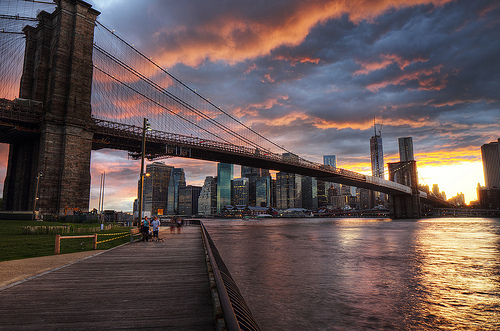
(Photo: CCHO)
NYC is one of the most amazing places in the world and certainly within America (it eventually got me as a full-time resident). Sometimes though, it feels like you can’t step out onto the street without spending $50.
I never thought I would enjoy living in such a metropolis but–as a traveler–NYC is the closest I can get to being everywhere in the world at once. On any given day, I’ll here a dozen languages and be able to eat Bhutanese for breakfast, Chinese for lunch, and Jamaican for lunch. If I want to see a movie at 2 am, I can do that too.
The prices of New York City are intimidating, but once you look past, through and around them, you realize that New York is a city filled with a plethora of ethnic enclaves, cheap meals, and free attractions.
ACCOMMODATIONS:
The hardest part about coming to New York City is finding cheap accommodation. Hotels have been pushing out hostels and trying to get the city to crack down on apartment rental services for a number of years now and they are succeeding – to our loss. Luckily, New Yorkers are creative and there are a number of ways you can still stay for cheap or free:
Choose Your Own Price – Hotwire and Priceline feature amazing deals for those willing to be given a random hotel. Using their blind booking feature, I have found hotels in Times Square for $80. And that’s Times Square, one of the most famous locations in the world. You can find rates cheaper than $50 if you expand your search outside Manhattan.
Jazz Hostels – One of the best hostels in Manhattan features some of the cheapest rates. Dorms start at $30 USD.
Couchsurfing – NYC features millions of hosts who are happy to show guests their city. Since hosts get inundated with tons of requests, ask early for the highest chance of success.
Airbnb – Despite the news, Airbnb is still alive and well in the city. Rooms start at $30 a night. Places outside Manhattan’s downtown area will be the cheapest.
Stay out of Manhattan – Like Hong Kong, Manhattan has the most expensive accommodation in the city, but boroughs such as Brooklyn and Queens have much cheaper food and lodging and are just a quick subway ride into the city.
The reason why people say, “New York is so expensive” is because they most look at hotel prices in Manhattan. But the NYC subway system is extensive and runs 24 hours a day. Lower your accommodation costs by staying outside Manhattan. It’s what most of the residents do, that’s for sure.
FOOD:
I get it. You want to come to NYC and eat well. The city has some of the best restaurants in the world but they take a huge bite out of your wallet. Save them for when you can afford them. For now, do what the rest of us do, and eat this way:
Eat at the food carts - You’ll find a million food cars in the city offers lots od different types of delicious and very inexpensive filling food. Check http://newyorkstreetfood.com/ to search by type of food to find locations.
Hot Dogs – Hot dog carts are everywhere, and a typical dog usually costs $2. For gourmet dogs, try Bark or Asia Dog. They cost around $5.00.
Pizza – Pizza is a staple food here in New York – there are more pizza shops than Starbucks. A single-topping slice is usually $2.50-$3.50 (historically, slices stay commensurate with the cost of a subway ride), but many offer plain cheese slices for only a buck. Look for shops clustered together as they get into price wars and offer the cheapest slices.
Chinatown Street food – Food carts on Canal Street (between Broadway and the Bowery) sell steamed, grilled, and fried Chinese food for $1-$2. Neighborhood dumpling stands offer 5 dumplings for a dollar. Prosperity Dumplings is my favorite. For the more intense Chinatown (what locals call the “Real Chinatown”, take the 7 train from Grand Central to the end of the line, Main Street in Flushing. Right next to the subway stop are dozens of stalls selling delicious eats for a dollar, roast duck and pork belly carts and basement food stalls with more cheap eats than you will know what to do with.
Falafel Stands – Tons of food trucks and stands sell quick and cheap falafel. For something a bit more established, visit Mamoun’s, which offers Baba Ganoush, falafel and kebabs for under $6. It’s located near Washington Square Park. There’s usually a line.
Great cheap tacos – Fabulous tacos around town, and more are opening every day. For authentic recipes in a great setting, try LES Taqueria on Orchard. Another great option is La Esquina on Kenmare, right in the middle of shopping districts. Don’t miss their elote either.
Some of my favorite places to eat are:
Chelsea Market (food stalls, local eats, farm-to-table)
Sao Mai, or Pho Bang (all Vietnamese)
Wondee Siam, Nahm (both Thai)
Bareburger, Corner Bistro, Siggy’s (each with delicious burgers)
Num Pang (Vietnamese sandwiches)
[NOTE FROM TIM: For a ton of my favorite spots in NYC, check this out -- The New York City Food Marathon: 26.2 Iconic Dishes in One 24-Hour Walking Tour.]
SIGHTSEEING TIPS:
One of the virtues of NYC is that you can sightsee some of its greatest attractions without spending anything.
To see the statue of liberty, take the Staten Island Ferry - That two-hour long line to see the Statue of Liberty not appealing? Well, walk a few blocks to the Staten Island ferry. The free ferry will take you across the harbor and give you a good view of both the Statue of Liberty and the city skyline. The ride takes about 20 minutes. In other words, you can see it for free and with no line!
Walk the Brooklyn Bridge – Walk across the Brooklyn Bridge to experience an interesting view of the New York skyline and harbor. It’s a long walk but good food and drinks (like the brewery) await you on the other side. Again—free.
Museum hop for free - NYC is littered with some of the best museums in the world, from the Met to the MoMa to the Guggenheim. Many museums offer free entry certain days of the week. The Whitney Museum of American Art is free on Fridays after 6 p.m., the Solomon R. Guggenheim has “suggested” donations after 5 p.m. on Saturdays, the Museum of American Folk Art is free, the Cooper-Hewitt National Museum of Design is free on Tuesday evenings free, the American Museum of Natural History is free, and the Metropolitan Museum of Art (Met) is also free (suggested donation is $20). The Museum of Modern Art (MoMa)– free admission Friday nights, 4 – 8pm (be warned, it’s a mob scene on Fridays).
Get Discounted Theater Tickets - You can’t come to NYC and not see a Broadway show. Tickets though can run hundreds of dollars, especially for the new and popular shows. Luckily, there’s a way to get discount tickets. The TKTS stand in Times Square offers 40-50% off select shows. You need to arrive at the counter the same day to see what they have but it’s usually a widespread and good selection. Be prepared to wait in line for about an hour. TKTS also have offices at the South Street Seaport and in Brooklyn.
Many shows offer cheap “rush” tickets (i.e. first come, first served tickets) on the day of the show. These are for tickets that often don’t sell well, like partially obstructed views or the last row of the balcony. So you get cheap tickets ($25-40) but not great seats. However, for sold-out hit shows, these are sometimes the only tickets to be found. The best resource for rush ticket information is Studentrush.org.
Top of the Rock – Right in Rockefeller center, you can head to the top of the building to see panoramic views of the city. This is better than going up to the Empire State building because with the top of the rock, you can get the Empire State building in your photos. While there are only slightly fewer tourists at the Top of the Rock, it’s a vastly less clichéd experience with a much shorter line.
Take a free tour – New York is a great place to walk around. However, only seeing New York from the outside is half the story. Take some of the free tours to see learn about the history of the city. The best tours:
The Central Park Conservancy offers several park tours each day based around certain themes: history, design, ecology, and horticulture.
The Grand Central Partnership gives tours of the famous terminal every Fridays at 12:30pm.
The Village Alliance leads walking tours of Greenwich Village, June – October.
The Lower East Side BID offers walking tours every Sunday at 11am, April – November. The tours last three hours.
Free Tours By Foot offers walking, food, and bike tours of NYC’s neighborhoods for free (though you should tip the guide!). There are multiple tours throughout the day making them easy to schedule.
Big Apple Greeter provides free walking tours, lead by locals, as part of a city tourism initiative. You’ll need to make reservations about a month in advance.
Federal Hall – Right next to Wall Street is an often-missed museum. Federal Hall is where George Washington, first president of the United States, was inaugurated in 1789. The hall, which is free and open to the public, showcases life in the city at that time as well as some information about the early founding of our government.
New York City may be famous as one of the most expensive cities in the world but sightseeing, eating, and drinking can all be done on a budget if you know where to look and how to navigate the system.***
If you can take three of the most expensive cities in the world and turn them into an affordable destinations, you can turn any dream destination into a reality. Just a few universal travel principles make travel to anywhere possible. Budget travel isn’t about being cheap; it’s about not being wasteful.
The tactics we’ve covered–using hotel and flight points, searching out alternatives to hotels, eating at tinier stalls, morning markets and less glitzy places, and using attraction passes – can work in any city. Traveling the world on $50 is more than just traveling by a simple number, it’s about being a smarter traveler. It’s about training yourself to look for deals in unknown places, to travel like locals live.
###
Matthew Kepnes runs the award winning budget travel site, Nomadic Matt . He got the travel bug after a trip to Costa Rica in 2004, and decided to quit his job, finish his MBA and travel the world. His book, How to Travel the World on $50 a Day –a guide for traveling cheaper, better, and longer–is now available.






July 31, 2013
Why (and How) Creative People Need to Say “No”

The following is a guest post by Kevin Ashton, the co-founder of the MIT Auto-ID Center, which created a global standard system for RFID and other sensors.
He also created the Internet of Things.
Enter Kevin
A Hungarian psychology professor once wrote to famous creators asking them to be interviewed for a book he was writing. One of the most interesting things about his project was how many people said “no.”
Management writer Peter Drucker: “One of the secrets of productivity (in which I believe whereas I do not believe in creativity) is to have a VERY BIG waste paper basket to take care of ALL invitations such as yours–productivity in my experience consists of NOT doing anything that helps the work of other people but to spend all one’s time on the work the Good Lord has fitted one to do, and to do well.”
Secretary to novelist Saul Bellow: “Mr. Bellow informed me that he remains creative in the second half of life, at least in part, because he does not allow himself to be a part of other people’s ‘studies.’”
Photographer Richard Avedon: “Sorry–too little time left.”
Secretary to composer György Ligeti: “He is creative and, because of this, totally overworked. Therefore, the very reason you wish to study his creative process is also the reason why he (unfortunately) does not have time to help you in this study. He would also like to add that he cannot answer your letter personally because he is trying desperately to finish a Violin Concerto which will be premiered in the Fall…”
The professor contacted 275 creative people. A third of them said “no.” Their reason was lack of time. A third said nothing. We can assume their reason for not even saying “no” was also lack of time and possibly lack of a secretary.
Time is the raw material of creation. Wipe away the magic and myth of creating and all that remains is work: the work of becoming expert through study and practice, the work of finding solutions to problems and problems with those solutions, the work of trial and error, the work of thinking and perfecting, the work of creating. Creating consumes. It is all day, every day. It knows neither weekends nor vacations. It is not when we feel like it. It is habit, compulsion, obsession, vocation. The common thread that links creators is how they spend their time. No matter what you read, no matter what they claim, nearly all creators spend nearly all their time on the work of creation. There are few overnight successes and many up-all-night successes.
Saying “no” has more creative power than ideas, insights and talent combined. No guards time, the thread from which we weave our creations. The math of time is simple: you have less than you think and need more than you know. We are not taught to say “no.” We are taught not to say “no.” “No” is rude. “No” is a rebuff, a rebuttal, a minor act of verbal violence. “No” is for drugs and strangers with candy.
Creators do not ask how much time something takes but how much creation it costs. This interview, this letter, this trip to the movies, this dinner with friends, this party, this last day of summer. How much less will I create unless I say “no?” A sketch? A stanza? A paragraph? An experiment? Twenty lines of code? The answer is always the same: “yes” makes less. We do not have enough time as it is. There are groceries to buy, gas tanks to fill, families to love and day jobs to do.
People who create know this. They know the world is all strangers with candy. They know how to say “no” and they know how to suffer the consequences. Charles Dickens, rejecting an invitation from a friend:
“‘It is only half an hour’–’It is only an afternoon’–’It is only an evening,’ people say to me over and over again; but they don’t know that it is impossible to command one’s self sometimes to any stipulated and set disposal of five minutes–or that the mere consciousness of an engagement will sometime worry a whole day… Who ever is devoted to an art must be content to deliver himself wholly up to it, and to find his recompense in it. I am grieved if you suspect me of not wanting to see you, but I can’t help it; I must go in my way whether or no.”
“No” makes us aloof, boring, impolite, unfriendly, selfish, anti-social, uncaring, lonely and an arsenal of other insults. But “no” is the button that keeps us on.
###
This post originally appeared on Medium.






July 30, 2013
Ketosis and Athletic Performance: More Than Fat Loss
The above video is a presentation by Peter Attia, M.D.
His talk is somewhat technical, but I always write blog posts hoping 20,000 people will *love* them, not that 1,000,000 will *like* them.
In this presentation, you will learn (in my words, not Pete’s):
- More about nutrition than most MDs learn in med school.
- How ketosis-adapted performance can aid fat loss and high-altitude resilience.
- Why the calorie estimates on treadmills and stationary bikes are complete BS.
- The three primary systems of energy production and basic organic chemistry, both of which aid understanding of all athletics.
Even if you struggle a little with vocabulary, the first 30 minutes are well worth watching a few times.
This talk made me immediately want to jump back on the Cyclical (or “Cyclic”) Ketogenic Diet (CKD), which was conceptually introduced to me in 1996-1998 by the writing of Lyle McDonald, Dr. Mauro Di Pasquale, and the late Dan Duchaine. It’s incredible for simultaneous fat loss and lean muscle gain, though perhaps needlessly complicated for non-athletes.
I usually limited the carb-reloading period to 12-18 hours after a glycogen depletion workout on Saturdays, though I experimented with moderate Wed night carb-ups (think DH Kiefer’s carb back-loading, though his version is much more methodical and effective) while training for sports like kickboxing.
If you’ve experimented with ketosis, what was your approach and experience? Pros and cons?
For additional reading, I suggest the following posts by Dr. Attia:
http://eatingacademy.com/nutrition/ketosis-advantaged-or-misunderstood-state-part-i
http://eatingacademy.com/nutrition/ketosis-advantaged-or-misunderstood-state-part-ii






July 24, 2013
A $36,000 Birthday Gift (Plus: Free Roundtrip Anywhere in the World)

I’m turning 36 years young! Here in a village in the Tigray Region of Ethiopia.
My 36th birthday is here!
It’s going to be a great natal year–I can already feel it. Perhaps it will be good luck for you, too. In this post, I’m giving away a round-trip ticket anywhere in the world.
But back to that strange birthday gift…
Much to the chagrin of my momma-san, I’ve become quite difficult to buy presents for. Some friends even think I’m impossible to find presents for. Not so. I love handwritten letters, homemade brownies, girlfriends in next-to-nothing, and–most of all–when people do something nice.
You, my dear readers, have an awesome track record of doing nice things.
For my b-day in 2010, you all raised more than $100,000 for high-need public school classrooms in the US. In 2011, you helped build libraries overseas (Cambodia, Nepal, Sri Lanka, and Vietnam), and last year, you helped poor youth in developing nations finish school.
In lieu of gifts this year, my birthday wish is to provide clean water to the people who need it most. I’m doing it on this page. There are fun prizes involved, so keep reading.
I recently traveled to the Tigray Region in Ethiopia with the incredible Charity: Water team. I witnessed, first-hand, what life is like for people living without clean, safe water.
Nearly 1 billion people worldwide fall into this group. For me, it’s not just a health issue. That’s not the most interesting part. If you want to offer a hand up (education, work) and not a hand out, water is highly leveraged for breaking the cycle of poverty.
In fact, every $1 invested in improved water access and sanitation can yield an average of $12 in economic returns.
Here’s how:
In Africa alone, people spend 40 billion hours every year (e.g. the entire annual workforce of France!) walking for water. Women and children usually bear the burden of water collection, walking for miles to the nearest source. The solution? Installing simple water wells for clean water in strategically close locations.
Children can then spend more time in classrooms learning, and women can contribute to their communities with their minds instead of carrying jerry cans most of the day.

A jerry can, 40 pounds when full.
Clean water creates more capable problem solvers in places with persistent problems. If you want to empower people instead of doling out aid indefinitely, this is a powerful starting point.
Here’s what I’d love to ask, and where the free roundtrip ticket comes in:
1. Join my 36th birthday challenge by clicking here. It’s worth clicking through just to check out the site. Donations are tax-deductible.
2. To get your engines started, I’ve put in $3,600 of my own money.
3. If the spirit moves you, please make a $36 donation (or whatever you can: $1, $36, $1,000, etc.) to providing clean water to those who need it most. Even a $1 can make a big difference!
4. Charity: Water sends 100% of every donation directly to fund projects in the field. No “administrative fees” or anything–every penny of every dollar goes to the field. Cool, right? And because I was just in Ethiopia, they’ll be sending it there. The best part: Charity: Water will report back in 18 months with GPS coordinates, photos and information about the communities we’ve impacted.
- If you all help raise $36,000, I will personally add another $5,000.
- If you all help raise $100,000 (100% doable), I’ll add on a total of $10,000.
- The deadline is 5pm PST on Friday, August 2nd, 2013.
Sweetening the Pot…
- I’m giving away a free round-trip ticket anywhere in the world that Star Alliance flies, which is just about everywhere. There is no expiration date on the trip, so no rush on deciding where or when to go. If you like, I’ll fly you to San Francisco to have dinner with me, but other places might be more interesting 
Here’s how to get it:
- Spread the word however you can. Send people to this post or to my Charity: Water birthday page. Here’s the URL for copying and pasting: http://my.charitywater.org/timferriss
- Leave a comment below telling me what you did (Facebook, Twitter, blog post, e-mail blast, e-mail signature, encouraged employees/friends to do the same, company donation matching, etc.). Measurement of any type gets huge bonus points. This comment must be put up no later than 5pm PST on Friday, August 2nd, 2013.
- Lastly, answer one question at the very top of your comment: “What does education mean to you?” Begin your answer with “To me, education means…”
Based on comments, I’ll pick the top five promoters. Then, you’ll all vote on the winner of the round-trip.
But the best reason of all to participate…
Beyond the bribes, you’ll feel awesome about yourself for doing real good for people who have so little. People who, without water, might not have much of a future at all.
Trust me. It feels great.
Will you pause for a moment and step up, even if for $1? It would mean the world to me. I’ll share updates as I get them.
Again, here is where to go to donate $1, $36, $360, or whatever you can.
Thank you for reading this post. You are all rock stars, and I continue to write on this blog purely because of you.
Pura vida!
Tim






July 17, 2013
Spearhead Capital: Looking for *ONE* Fast-Growing Start-Up to Take Mainstream

(Photo: Andrew Atkinson)
I am looking for one great company to put my name, brand, and entire network behind.
Usually, I do this through advising, and my start-ups include Uber, Evernote, Automattic (WordPress.com), and Shopify, among others. I’ve been with some of them from pre-seed money to $1-billion valuations.
Here’s my full bio and credentials, and below is a testimonial from one of my start-ups:
“Tim has played a huge part in putting Shopify on the map. He has been an advisor to Shopify since 2009, and he’s been invaluable in the growth of our business.
Back when no one knew about us, we were brainstorming with him. He challenged us to prove that building an online business was in fact as easy as we claimed. In order to accomplish that, and under Tim’s guidance and leadership, we created the Shopify Build-a-Business competition. Now, it’s one of the most important things that we do.
In the most recent Build-a-Business contest alone, more than 12,000 brand-new shops sold more than $55 million in products. It’s become the most popular ‘online retail’ competition in the world.
This helped Shopify ‘cross the chasm’ in terms of pushing Shopify’s brand to a mainstream audience.
It was risky, but Tim knew it would succeed – it was entirely consistent with his track record for PR and Marketing. Simply put, Tim is our secret weapon!”
- Harley Finkelstein, CPO
Shopify – The world’s most popular ecommerce platform for small businesses, currently powering more than 60,000 online stores that sell more than $1B in products annually. Shopify also powers stores for brands like Gatorade, Forbes, Budweiser, The Chive, and more.
Back to Spearhead Capital…
This time, I’m doing things differently: I’m raising an entire round of financing for one company… with unusual perks. I’ve been planning this for a long time, and it’s only possible now.
Here’s what it looks like…
CRITERIA
You should want (or be willing) to raise $500,000-$1,000,000, and here are the benefits of doing it with me:
- I won’t take a board seat, so you retain all control.
- Massive national PR/exposure. This is going to get a LOT of attention, and I’m famous for maximizing impact (e.g. Forbes’ “The Tim Ferriss Effect” and AdAge awards for product launches).
- VCs usually want a minimum of 20% ownership. You can sell as little (or much) % as you want here.
- Once VCs see you succeed, you are in a massive position of strength and will probably receive unsolicited term sheets. This flips the tables. If you want optimal leverage for a larger round (say $5-10M total), raising a small amount with me makes sense.
- Minimal disclosure. You don’t have to pitch to investors and potential competitors.
What I’m looking for:
- Consumer-facing product/service (e.g. Evernote, StumbleUpon, Uber, etc.), or small-business focused product/service (e.g. Shopify), not enterprise software.
- 100K active users OR serial founder(s) with past exits OR 10K paying customers.
- 10% month-on-month activity growth.
- Clean cap table, minimal previous financing (or none), no bridge rounds.
- If you’re in “stealth” mode, you’d have to come out of stealth when I start fundraising, which would only last a few weeks.
- US-based companies, or companies willing to create US-based investable entities (which is easy). Shopify started in Canada, for instance.
Interested? I’m psyched. Please fill out this form. Deadline is July 25, 2013 at 5pm EST, and I’ll be in touch!
VERY big things ahead.
###
Please note: I’m only recruiting the start-up at this point in time. I’m not talking publicly about the mechanisms or process, so thanks for understanding if I can’t answer many questions in the comments.






July 14, 2013
How to Travel: 21 Contrarian Rules
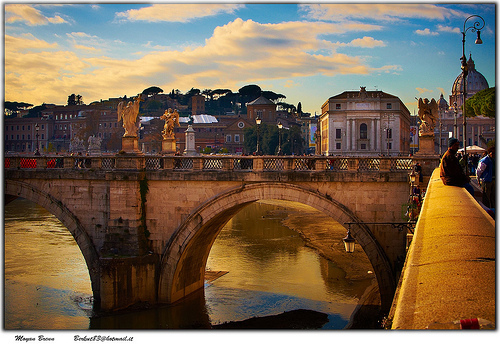
(Photo credit: Moyan Brenn)
This is a tactical post on travel from Ryan Holiday, who’s written on this blog before about the pragmatism of Stoicism and lessons learned as Director of Marketing for American Apparel.
To his 21 rules, I’ve added a few of my own tricks. Please share your own rules and tips in the comments!
Enter Ryan Holiday
Why are you traveling?
Because, you know, you don’t magically get a prize at the end of your life for having been to the most places. There is nothing inherently valuable in travel, no matter how hard the true believers try to convince us.
Seneca, the stoic philosopher, has a great line about the restlessness of those who seem compelled to travel. They go from resort to resort and climate to climate, he says, and continues:
“They make one journey after another and change spectacle for spectacle. As Lucretius says ’Thus each man flees himself.’ But to what end if he does not escape himself? He pursues and dogs himself as his own most tedious companion. And so we must realize that our difficulty is not the fault of the places but of ourselves.”
It’s hard for me see anything to envy in most people who travel. Because deep down that is what they are doing. Fleeing themselves and the lives they’ve created. Or worse, they’re telling themselves that they’re after self-discovery, exploration or new perspectives when really they are running towards distraction and self-indulgence.
Is that why you’re packing up your things and hitting the road?
Not that I don’t travel myself–I did my fair share this year alone. Both coasts of Australia. I was in Amsterdam for a speaking gig (and I found myself at a tulip farm with Tim where he caught a chicken with his bare hands). I researched for my next book in Rome. I went down to Brazil. I went to Copenhagen. I spent enough time in New York that it felt like I lived there. I road tripped across the United States more times than I can count–New Orleans to New York; New York to Miami; Miami to Austin… The list goes on. If there was a chance to go somewhere I’d never been, I tried to take it, especially if it was historic.
But are you, as Emerson once put it, ”bringing ruins to the ruins?”…
The purpose of travel, like all important experiences, is to improve yourself and your life. It’s just as likely–in some cases more likely–that you will do that closer to home and not further.
So what I think about when I travel is that “why.” (Some example “whys” for me: research, to unplug, a job or a paying gig, to show something that’s important to me to someone who is important to me, etc.) I don’t take it as self-evident that going to a given famous place is an accomplishment in and of itself. There are just as many fools living in Rome as there are at home.
And when you make this distinction, most of the other travel advice falls away. The penny pinching and the optimization, the trying to squeeze as many landmarks into a single day, all that becomes pointless and you focus on what matters.
I am saying that saving your money, plotting your time off work or school, diligently tracking your frequent flyer miles and taking a hostel tour of Europe or Asia on budget may be the wrong way to think about it.
In the vein of my somewhat controversial advice for young people, I thought I’d give some of my thoughts not just on traveling but on how to do it right.
My 21 Travel Rules and Criteria
1. Don’t check luggage. If you’re bringing that much stuff with you, you’re doing something wrong.
[TIM: I second this and encourage you to take things to extremes. Here's exactly how I travel the world with 10 pounds or less.]
2. Instead of doing a TON of stuff. Pick one or two things, read all about those things and then actually spend time doing them. Research shows that you’ll enjoy an experience more if you’ve put effort and time into bringing it about. So I’d rather visit two or three sights that I’ve done my reading on and truly comprehend than I would seeing a ton of stuff that goes right in and out of my brain. (Oh, and never feel “obligated” to see the things everyone says you have to)
[TIM: Need some inspiration? Here are my highlight lists for Tokyo and Buenos Aires.]
3. Take long walks.
4. Stop living to relive. What are you taking all these pictures for? Oh, for the memories? Then just look at it and remember it. Experience the present moment. (Not that you can’t take photos but try to counteract the impulse to look at the world through your iPhone screen)
5. Read books, lots of books. You’re finally in a place where no one can interrupt you or call you into meetings and since half the television stations will be in another language…use it as a chance to do a lot of reading.
[TIM: I strongly suggest that non-fiction bigots (which I was for 15+ years) read or listen to some fiction to turn off their problem-solving minds. Try The Graveyard Book audiobook or Zorba the Greek.
6. Eat healthy. Enjoy the cuisine for sure, but you’ll enjoy the place less if you feel like a slob the whole time. (To put it another way, why are you eating pretzels on the airplane?)
[TIM: If you want to follow The Slow-Carb Diet, my default cuisine choices in airports are Thai and Mexican food. Also, keep a *small* bag of almonds in your bag to avoid digressions in emergencies.]
7. Try to avoid guidebooks, which are superficial at best and completely wrong at worst. I’ve had a lot more luck pulling up Wikipedia, and looking at the list of National (or World) Historical Register list for that city and swinging by a few of them. Better yet, I’ve found a lot cooler stuff in non-fiction books and literature that mentioned the cool stuff in passing. Then you Google it and find out where it is.
[TIM: I like to spend an afternoon visiting hostels, even if I'm staying in an apartment or hotel. The hostel staff will know which free and low-cost activities get the best reviews from the non-museum-going crowd.]
8. I like to go and stand on hallowed ground. It’s humbling and makes you a better person. Try it. (My personal favorite is battlefields–nothing is more eery or quiet or peaceful)
9. Come up with a schedule that works for you and get settled into it as soon as possible. You’re going to benefit less from your experiences if you’re scrambled, exhausted and inefficient. Me, I get up in the morning early and run. Then I work for a few hours. Then I roll lunch and activities into a 3-4 hour block where I am away from work and exploring the city I’m staying it. Then I come back, work, get caught up, relax and then eventually head out for a late dinner. In almost every time zone I’ve been in, this seems to be the ideal schedule to a) enjoy my life b) Not actually count as “taking time off.” No one feels that I am missing. And it lets me extend trips without feeling stressed or needing to rush home.
10. When you’re traveling to a new city, the first thing you should do when you get to the hotel is change into your work out clothes and go for a long run. You get to see the sights, get a sense of the layout and then you won’t waste an hour of your life in a lame hotel gym either.
11. Never recline your seat on an airplane. Yes, it gives you more room–but ultimately at the expense of someone else. In economics, they call this an externality. It’s bad. Don’t do it.
12. Stay in weird-ass hotels. Sometimes they can suck but the story is usually worth it. A few favorites: A hotel that was actually a early 20th-century luxury train car, a castle in Germany, the room where Gram Parsons died in Palm Desert, a hotel in Arizona where John Dillinger was arrested, and a hotel built by Wild Bill Hickok.
13. Read the historical markers–*actually* read them, don’t skim. They tend to tell you interesting stuff.
14. Add some work component to your travel if you can. Then you can write it all off on your taxes (or better, be paid for the whole thing).
[TIM: Here's how an entire family moved to a tropical paradise in Indonesia and continued to earn income.]
15. Don’t waste time and space packing things you MIGHT need but could conceivably buy there. Remember, it costs money (time, energy, patience) to carry pointless things around. (Also, most hotels will give you razors, toothbrushes, toothpaste and other toiletries.)
16. Go see weird shit. It makes you think, shake your head, or at least, laugh. (For instance, did you know that there is a camel buried in the soldier’s cemetery at Vicksburg?)
[TIM: If you go to Japan, don't miss the incredible Ghibli Museum, made by animator Hayao Miyazaki and located in Inokashira Park.]
17. Ignore the temptation to a) talk and tell everyone about your upcoming trip b) spend months and months planning. Just go. Get comfortable with travel being an ordinary experience in your life and you’ll do it more. Make it some enormous event, and you’re liable to confuse getting on a plane with an accomplishment by itself.
18. Regarding museums, I like Tyler Cowen’s trick about pretending you’re a thief who is casing the joint. It changes how you perceive and remember the art. Try it.
19. Don’t upgrade your phone plan to international when you leave the country. Not because it saves money but because it’s a really good excuse to not use your cellphone for a while. (And if you need to call someone, try Google Voice. It’s free)
20. Explore cool places inside the United States. The South is beautiful and chances are you haven’t seen most of it. There’s all sorts of weird history and wonderful things that your teachers never told you about. Check it out, a lot of it is within a drive of a day or two.
[TIM: Here are 12+ gems of the Pacific Northwest, encountered on a road trip from San Francisco to Whistler, Canada.]
[TIM: 21. OK, this one's from me, just because it's so much fun. Take pictures of yourself jumping in different places! It can turn a boring "adult" afternoon into a giddy kid-like experience. The below is from Burning Man 2010.]
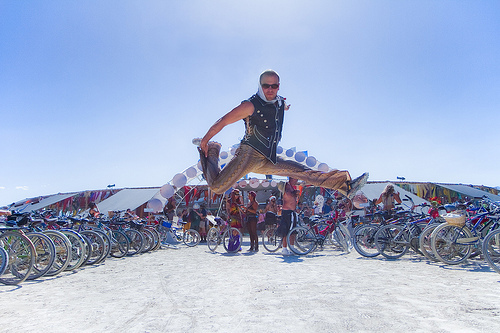
(Photo: Mike Hedge)
In other words…
Travel should not be an escape. It should be part of your life, no better or no worse than the rest of your life. If you are so dissatisfied with what you do or where you live that you spend weeks and months figuring out how to get a few days away from either, that should be a wake-up call. There’s a big difference between *wanting* a change in scenery and *needing* to run away from a prison of your own making.
To me, there is more to admire in someone who challenges their perspectives and lifestyle choices at home than in some Instagram addict who conflates meaning with checking off boxes on a bucket list.
[TIM: I'm a fan of bucket lists, but different strokes for different folks...]
So ask: Do you deserve this trip? Ask yourself that honestly. Am I actually in a place to get something out of this?
Over the years, I feel like I have mastered the art of something I wouldn’t call “travel.” I’d call it living my life in interesting places.
These rules and tricks have helped make that possible, and maybe they’ll work for you, too.
###
What rules and tools have worked for you? Please share in the comments!
(A much shorter version of this piece, without my comments, first appeared in Thought Catalog.)










